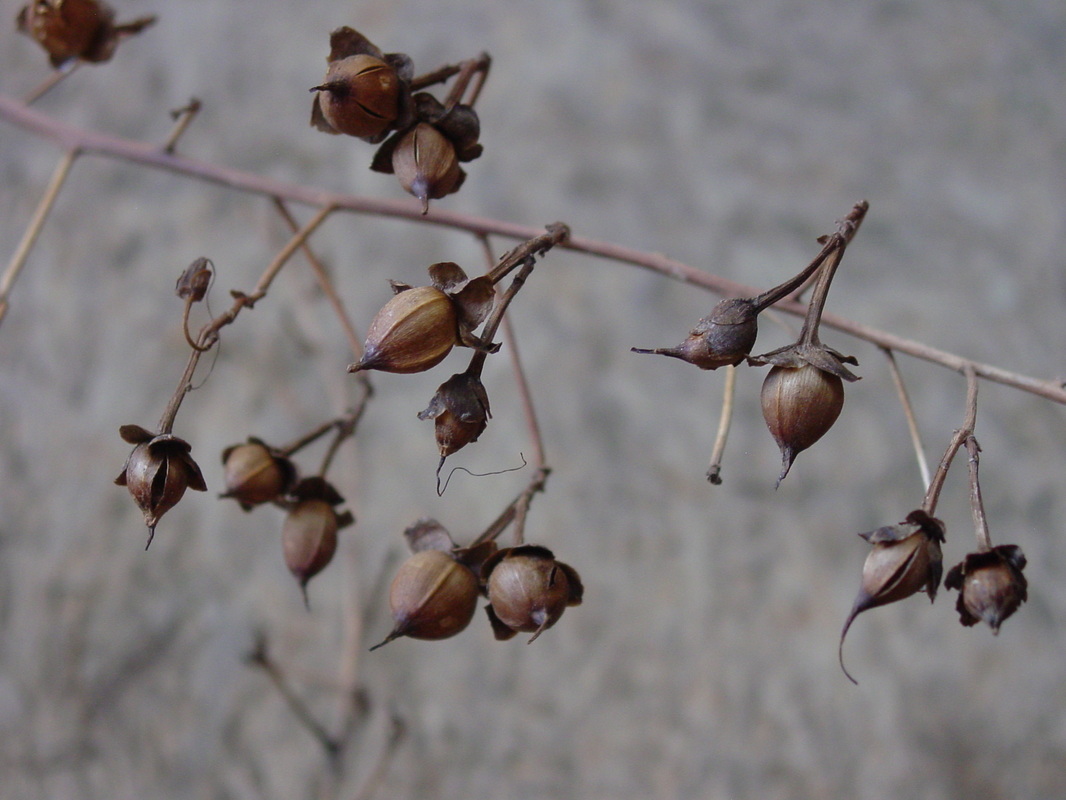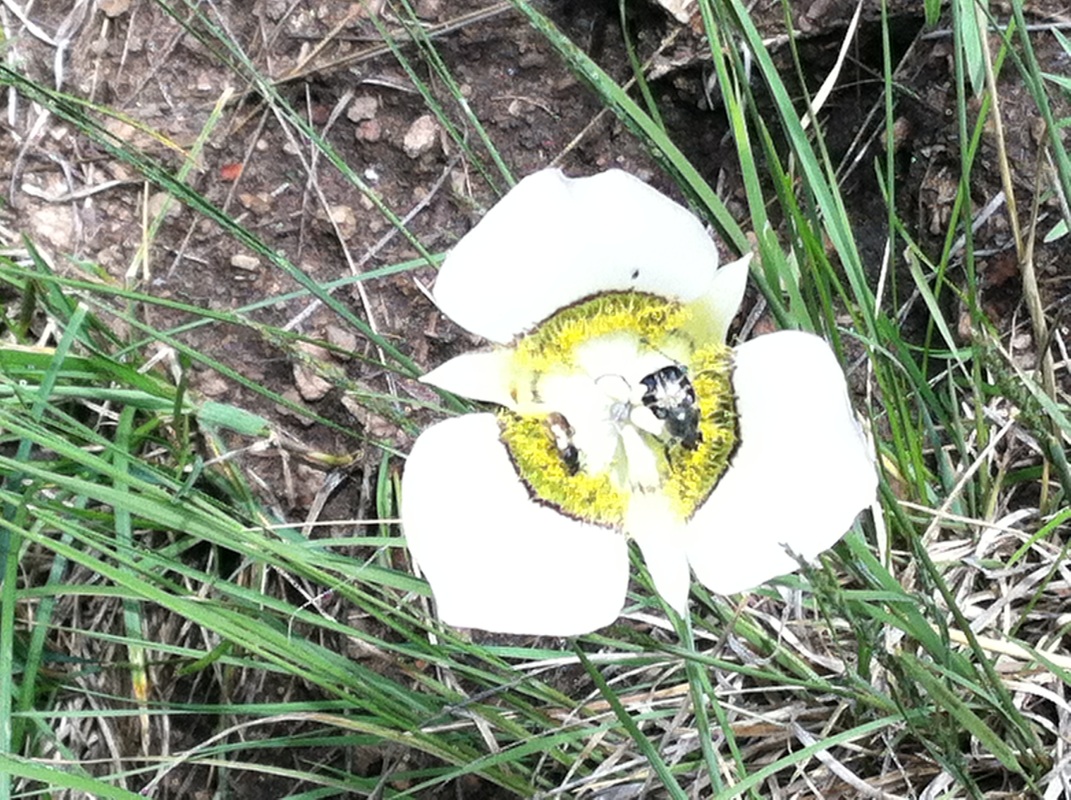Miss Penn's Mountain Seed
WILD MOUNTAIN SEED
High-Altitude Seed For The Mountain Gardener
The Store is OPEN for 2024.
Planting seeds is very healing and hopeful and gives you clean food and a happy heart.
From our mountain to all of you, be well and thank you!
All wild seed listed below is hand collected by me. All seed is collected sustainably and responsibly. Much of the seed comes from my own mountain property. Elevation is noted on all seed so you can see who grows where. You do not have to match elevations - however, some things need to grow up high - other's need the heat of the Colorado Steppe or similar conditions to survive.
Some of this seed is very rare and hard to collect. New things will be added and some things might be taken down - so if it's listed - order before it's gone. Complete descriptions and pictures coming very soon.
To Order:
Go to the Store and search Wild Seed!
Thank you for considering my Bio-regional seed. You are on the path to food security and sustainability when you seek out locally grown and adapted seed.
Some of this seed is very rare and hard to collect. New things will be added and some things might be taken down - so if it's listed - order before it's gone. Complete descriptions and pictures coming very soon.
To Order:
Go to the Store and search Wild Seed!
Thank you for considering my Bio-regional seed. You are on the path to food security and sustainability when you seek out locally grown and adapted seed.
GARDEN FLOWERS AND HERBS AT THE BOTTOM OF THIS PAGE
SCROLL DOWN FOR MORE
SCROLL DOWN FOR MORE
WILD SEED LIST FOR 2023
Miss Penn's Mountain Seeds
But first, the photos...
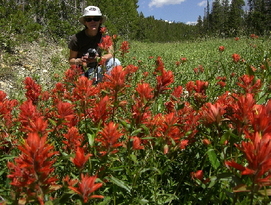 Mary in the wild.
Mary in the wild.
I am proud to feature the stunning photographs of Mary L. Dubler DVM of Fort Collins, Co.
Click here to see her website: Wildflowers of Colorado.
Really, go - see her work - get lost in her pictures of our beautiful Colorado natives. www.wildflowersofcolorado.com
All of Mary's photos are marked "Wildflowers of Colorado".
Click here to see her website: Wildflowers of Colorado.
Really, go - see her work - get lost in her pictures of our beautiful Colorado natives. www.wildflowersofcolorado.com
All of Mary's photos are marked "Wildflowers of Colorado".
The Wild Things...

Aconitum columbianum
Monkshood
(Wolfsbane)
Oooooolalala! Remember Snape in Harry Potter asking Harry if he knew another name for Wolfsbane? Hermione had her hand up madly and poor Harry knew nothing about plants? I was shouting "Aconitum, Aconitum!!!". Ah yes, raising boys....
So this glorious flower is completely poisonous - all parts. Although a powerful medicine, it has been a beloved garden flower since gardens were created and it is a great flower to add to a moist, shady place. I wear gloves when handling the plants and seeds and children should be taught to beware as it can cause skin irritation. Of course do not ingest any part of the plant.
I find it deep in the forest along the creek - almost growing out of the creek. We are usually eye to eye as it can grow 3-6'. It is very impressive in flower as you can see - plants tell us who they are. The leaves are similar to Delphinium.
Like Delphinium, the elk eat it to get high and I am often late to collect the few seedpods they leave me. Gorgeous. It can grow in the garden bed with ample water. It can throw the deepest blue/purple flowers to white and lavender/bi-color in between.
Although it is not necessary, you can cold-stratify for a couple of months, plant in fall or just try it as soon as you receive the fresh seeds - it wants to grow.
Perennial
Monkshood
(Wolfsbane)
Oooooolalala! Remember Snape in Harry Potter asking Harry if he knew another name for Wolfsbane? Hermione had her hand up madly and poor Harry knew nothing about plants? I was shouting "Aconitum, Aconitum!!!". Ah yes, raising boys....
So this glorious flower is completely poisonous - all parts. Although a powerful medicine, it has been a beloved garden flower since gardens were created and it is a great flower to add to a moist, shady place. I wear gloves when handling the plants and seeds and children should be taught to beware as it can cause skin irritation. Of course do not ingest any part of the plant.
I find it deep in the forest along the creek - almost growing out of the creek. We are usually eye to eye as it can grow 3-6'. It is very impressive in flower as you can see - plants tell us who they are. The leaves are similar to Delphinium.
Like Delphinium, the elk eat it to get high and I am often late to collect the few seedpods they leave me. Gorgeous. It can grow in the garden bed with ample water. It can throw the deepest blue/purple flowers to white and lavender/bi-color in between.
Although it is not necessary, you can cold-stratify for a couple of months, plant in fall or just try it as soon as you receive the fresh seeds - it wants to grow.
Perennial
 Pale Mountain False-Dandelion - Pic by Penn
Pale Mountain False-Dandelion - Pic by Penn
Agoseris glauca
Pale Mountain False-Dandelion
Perennial
This lovely yellow flower grows from the Steppe to the Alpine and has a sweet way of nestling in the rocky soils of the intermountain west.
The basal rosette has strappy leaves and each flower tops a leaf-less stem. Grows to 2' but I find them around 12-18".
Plant in fall or early winter or cool moist stratify for 2 months before planting. Barely cover the seeds and press them in for good seed-to-soil contact.
Pale Mountain False-Dandelion
Perennial
This lovely yellow flower grows from the Steppe to the Alpine and has a sweet way of nestling in the rocky soils of the intermountain west.
The basal rosette has strappy leaves and each flower tops a leaf-less stem. Grows to 2' but I find them around 12-18".
Plant in fall or early winter or cool moist stratify for 2 months before planting. Barely cover the seeds and press them in for good seed-to-soil contact.

Allium cernuum
Nodding Onion – 9-10,000’ - Limited Quantity
Edible, easy to grow, beautiful. What more could we want? This is such a cool plant. Great for rock gardens or under trees in dappled light. Grows along the forest edge, on roads cuts, amongst rocks.
Super adaptable. Reseeds easily. Lovely. Eat fresh or cook it for two very different flavors. Medicinal.
12-18" tall, nodding lavender flowers on slender onion stems. Even though I don't think anything is deer resistant, this is as close as this gets. Perennial.
Nodding Onion – 9-10,000’ - Limited Quantity
Edible, easy to grow, beautiful. What more could we want? This is such a cool plant. Great for rock gardens or under trees in dappled light. Grows along the forest edge, on roads cuts, amongst rocks.
Super adaptable. Reseeds easily. Lovely. Eat fresh or cook it for two very different flavors. Medicinal.
12-18" tall, nodding lavender flowers on slender onion stems. Even though I don't think anything is deer resistant, this is as close as this gets. Perennial.
 Small-Leaf Pussy Toes - Pic by Penn
Small-Leaf Pussy Toes - Pic by Penn
OUT OF STOCK!
Antennaria parviflora
Small-Leaf Pussy Toes
Perennial
This creeping ground cover grows from 3-16". In higher elevations, expect it to stay short and compact. The early flowers can be pure white or have a rosy glow. They open to pure white flowers that look like a kitten's toes above wonderful, silver leaves that stay close to the earth.
This plant can grow in dry shade, open meadows and mixed forests - it is highly adaptable and can perform in many micro-climates. It grows all over the western states and is quite drought tolerant. I see it growing in gravelly soil and amongst the rocks. It has a mat like appearance and remains evergreen in winter.
Easy to grow, plant outside in spring or summer, press the seed into the surface of the soil but do not cover.
Picture shows flowers going to seed.
Antennaria parviflora
Small-Leaf Pussy Toes
Perennial
This creeping ground cover grows from 3-16". In higher elevations, expect it to stay short and compact. The early flowers can be pure white or have a rosy glow. They open to pure white flowers that look like a kitten's toes above wonderful, silver leaves that stay close to the earth.
This plant can grow in dry shade, open meadows and mixed forests - it is highly adaptable and can perform in many micro-climates. It grows all over the western states and is quite drought tolerant. I see it growing in gravelly soil and amongst the rocks. It has a mat like appearance and remains evergreen in winter.
Easy to grow, plant outside in spring or summer, press the seed into the surface of the soil but do not cover.
Picture shows flowers going to seed.

Arctostaphylos uva-ursi
Kinnick-kinnick - 9-10,000’
Perennial
"Bear Berry". Sometimes when I am collecting this, I find bear scat made up of solid berries. I realize the bear is probably sleeping nearby and I keep an eye on how far I am away from my car! During hunting season, since I wear a lot of black, I also wear orange over my seed apron...
This berry was used in pemmican, a mixture of pounded meat, fat and berries, and can also be prepared as tea. Leaves were smoked by indigenous people. Medicinal.
Beautiful white and pink bells come in spring followed by a brilliant red berry in fall. Evergreen plants sprawl on the ground throughout the forest floor.
Grows to 6" - 1'. This important plant grows all over the Rockies.
Kinnick-kinnick - 9-10,000’
Perennial
"Bear Berry". Sometimes when I am collecting this, I find bear scat made up of solid berries. I realize the bear is probably sleeping nearby and I keep an eye on how far I am away from my car! During hunting season, since I wear a lot of black, I also wear orange over my seed apron...
This berry was used in pemmican, a mixture of pounded meat, fat and berries, and can also be prepared as tea. Leaves were smoked by indigenous people. Medicinal.
Beautiful white and pink bells come in spring followed by a brilliant red berry in fall. Evergreen plants sprawl on the ground throughout the forest floor.
Grows to 6" - 1'. This important plant grows all over the Rockies.

Argemone polyanthemos
Prickly Poppy
Annual or Biennial 2-3' Collected at 7,888'.
I've loved this plant all of my life, marveling at the heat it can take and the ants that climb it and the bees that buzz it. This flower is bad-ass - the flower is as delicate and fragile as any poppy but the plant will bite you hard. Blue-green thistle-like spikey leaves ain't playin'. You will bleed if you mess around with it. Collecting seed is exciting! Plant it where it can be and reseed and make a stand. Gorgeous from the high heat to the mountain top.
Plant outside in fall. Plant on the surface and cover with a little sand. Can grow to 3'. Blooms June/July. Perennial.
Prickly Poppy
Annual or Biennial 2-3' Collected at 7,888'.
I've loved this plant all of my life, marveling at the heat it can take and the ants that climb it and the bees that buzz it. This flower is bad-ass - the flower is as delicate and fragile as any poppy but the plant will bite you hard. Blue-green thistle-like spikey leaves ain't playin'. You will bleed if you mess around with it. Collecting seed is exciting! Plant it where it can be and reseed and make a stand. Gorgeous from the high heat to the mountain top.
Plant outside in fall. Plant on the surface and cover with a little sand. Can grow to 3'. Blooms June/July. Perennial.
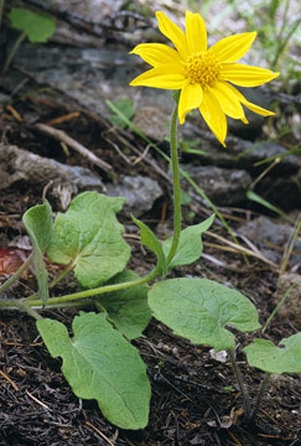 Pic by Penn
Pic by Penn
Arnica cordifolia
Heart-leaf Arnica
Found way up high in the forest, between 9-10,000', heart-leafed Arnica is hard to miss, absolutely stunning in half-shade to full sun. I see it running along the forest' edge - reaching toward the sun.
Heart-shaped leaves are clearly identifiable.
Yes, this variety is medicinal and it's native to Colorado but I particularly like it since my husband's name is Cord and the leaves are hearts. :)
I always want to roll around in it - grow some so you can too!
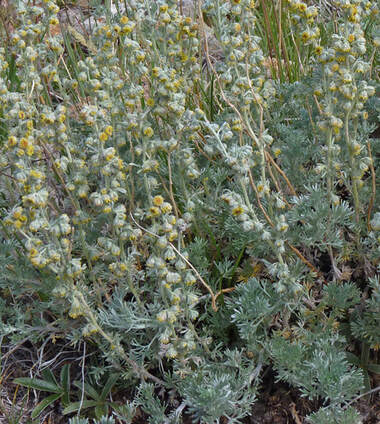
Artemisia frigida
Fringed Sage – 8-10,000’
Perennial - woody stem
I adore this plant. The Best Dog That Ever Lived - a red Dobie named Coco - used to roll upside down and backwards on a carpet of young plants to clean and perfume herself. Besides being beautiful, soft and aromatic, it is also good medicine.
Indigenous People used it for cold, gastritis, wounds, coughs, headache, heartburn, fever, etc.
It is a food source for White-tailed Jackrabbit, Sage Grouse, Elk, Deer and Pronghorn.
In spring, it grows a soft, silver, grey/green mound that shoots up flower stalks to bloom June, July, August. It grows happily here amongst the Blue Grama. Tiny, insignificant yellow flowers nod along the stem.
Essential. Yes, you can make it into a smudge stick and yes, it smells wonderful. I've known this plant all of my life, it grows in most places - including the high and the low. Excellent ground cover and soil stabilizer. Thrives in poor soil and is drought tolerant. Easy to germinate seeds or divide.
Provides nesting materials for native bees.
Also called Prairie Sagewort, Arctic Sage, Pasture Sage.
Fringed Sage – 8-10,000’
Perennial - woody stem
I adore this plant. The Best Dog That Ever Lived - a red Dobie named Coco - used to roll upside down and backwards on a carpet of young plants to clean and perfume herself. Besides being beautiful, soft and aromatic, it is also good medicine.
Indigenous People used it for cold, gastritis, wounds, coughs, headache, heartburn, fever, etc.
It is a food source for White-tailed Jackrabbit, Sage Grouse, Elk, Deer and Pronghorn.
In spring, it grows a soft, silver, grey/green mound that shoots up flower stalks to bloom June, July, August. It grows happily here amongst the Blue Grama. Tiny, insignificant yellow flowers nod along the stem.
Essential. Yes, you can make it into a smudge stick and yes, it smells wonderful. I've known this plant all of my life, it grows in most places - including the high and the low. Excellent ground cover and soil stabilizer. Thrives in poor soil and is drought tolerant. Easy to germinate seeds or divide.
Provides nesting materials for native bees.
Also called Prairie Sagewort, Arctic Sage, Pasture Sage.

Asclepias speciosa
Showy Milkweed
Perennial Collected at 7,000'.
Monarch Butterflies - come and feast! Be a part of the movement to help the Monarch recover from their decreasing numbers by feeding them along their journey.
2-3' glorious plant with 3" blooms often covered in butterflies. The seed pods are a thing of beauty as well - releasing their seed on glamorous parachutes.
Grows wild in Colorado, collected at 7,000'.
Showy Milkweed
Perennial Collected at 7,000'.
Monarch Butterflies - come and feast! Be a part of the movement to help the Monarch recover from their decreasing numbers by feeding them along their journey.
2-3' glorious plant with 3" blooms often covered in butterflies. The seed pods are a thing of beauty as well - releasing their seed on glamorous parachutes.
Grows wild in Colorado, collected at 7,000'.
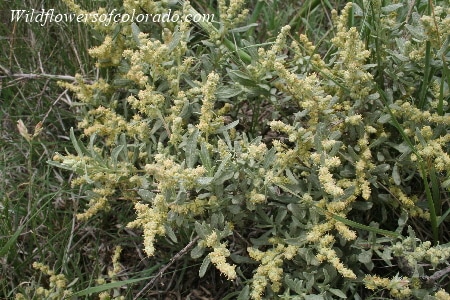
Atriplex canascens
Four-Wing Saltbush - 5,000-7,000’
Drought tolerant long lived perennial shrub grows high and low all over the west. The seeds have four wings and are quite showy. Grey green leaves on woody stems. Used for centuries as fuel, dye, medicine and the ashes were used for the nixtamalization of maize. Often grows in great colonies and plants are most often dioecious, (some plants are males, some are females), but this plant can change sex whenever environmental conditions dictate. Super cool staple of the high and dry garden. Showy in seed. Yellow flowers.
Plant in fall or winter in groups of ten seeds, on the third year when the plant sets seed, you can thin them so one male to every five females remain. This plant can grow 1-8' in height and width. Prefers sandy, gravelly seed and low water.
Four-Wing Saltbush - 5,000-7,000’
Drought tolerant long lived perennial shrub grows high and low all over the west. The seeds have four wings and are quite showy. Grey green leaves on woody stems. Used for centuries as fuel, dye, medicine and the ashes were used for the nixtamalization of maize. Often grows in great colonies and plants are most often dioecious, (some plants are males, some are females), but this plant can change sex whenever environmental conditions dictate. Super cool staple of the high and dry garden. Showy in seed. Yellow flowers.
Plant in fall or winter in groups of ten seeds, on the third year when the plant sets seed, you can thin them so one male to every five females remain. This plant can grow 1-8' in height and width. Prefers sandy, gravelly seed and low water.
 Rocky Mountain Columbine - Pic by Penn
Rocky Mountain Columbine - Pic by Penn
Aquilegia caerulea
Rocky Mountain Blue Columbine
Perennial
The Colorado State Flower! Blue and White with Yellow anthers, to see this in its natural habitat is a wondrous moment. Absolutely gorgeous! Columbine can grow in full sun but prefers dappled light. I often see it under Aspens and in mixed forests.
It likes cool temps and somewhat moist soil. Deer love this plant above all I think so plant it in a protected spot. It forms beautiful clumps of soft leaves with these wonderful flowers rising to 30". Very hardy.
Plant in fall or moist stratify for 60 days. Barely cover the seed.
Rocky Mountain Blue Columbine
Perennial
The Colorado State Flower! Blue and White with Yellow anthers, to see this in its natural habitat is a wondrous moment. Absolutely gorgeous! Columbine can grow in full sun but prefers dappled light. I often see it under Aspens and in mixed forests.
It likes cool temps and somewhat moist soil. Deer love this plant above all I think so plant it in a protected spot. It forms beautiful clumps of soft leaves with these wonderful flowers rising to 30". Very hardy.
Plant in fall or moist stratify for 60 days. Barely cover the seed.
 Western Columbine - Pic by Kai
Western Columbine - Pic by Kai
Aquilegia formosa
Western Columbine
Perennial
All Columbines are truly stunning, especially when encountered in the wild, and this bi-colored beauty is no exception. Red and yellow flowers rise above blue-green deeply cut leaves. The plants make lovely mounds and naturalize by seed. They look delicate yet showy and fit right in amongst the trees of a mixed forest.
They can take full sun but also appreciate afternoon shade or dappled light. They grow to 3' and like rocky soil and can thrive in dry to moist soil. Once established, they will reseed themselves easily. They bloom from May to Aug.
Hummingbirds and pollinators love Columbine and so do deer. They love the leaves, they love the flowers, the flower buds and the seeds. So, plant them in a protected area.
Direct seed in spring or fall, barely cover the seed. Press it in gently for good seed-to-soil contact.
Western Columbine
Perennial
All Columbines are truly stunning, especially when encountered in the wild, and this bi-colored beauty is no exception. Red and yellow flowers rise above blue-green deeply cut leaves. The plants make lovely mounds and naturalize by seed. They look delicate yet showy and fit right in amongst the trees of a mixed forest.
They can take full sun but also appreciate afternoon shade or dappled light. They grow to 3' and like rocky soil and can thrive in dry to moist soil. Once established, they will reseed themselves easily. They bloom from May to Aug.
Hummingbirds and pollinators love Columbine and so do deer. They love the leaves, they love the flowers, the flower buds and the seeds. So, plant them in a protected area.
Direct seed in spring or fall, barely cover the seed. Press it in gently for good seed-to-soil contact.

Bahia dissecta
Yellow Ragleaf
Biennial 2-3' Collected at 8,120'.
The common name does not do this beauty justice. Tall, willowy sprays of rounded yellow ray flowers grow out of rock if they want to. They reseed delightfully and pop up amongst the potted flowers as easily as it grows alone in the dry woods at 8,120'. Perfect in bouquets as it is 2-3' tall and the stem is long with a spray of these little flowers above.
The first year rosette has finely cut leaves, very pretty.
Easy to grow, plant in Spring, Summer or Fall. Plant seeds 1/8" in lean, sandy soil. Blooms July/Sept.
Yellow Ragleaf
Biennial 2-3' Collected at 8,120'.
The common name does not do this beauty justice. Tall, willowy sprays of rounded yellow ray flowers grow out of rock if they want to. They reseed delightfully and pop up amongst the potted flowers as easily as it grows alone in the dry woods at 8,120'. Perfect in bouquets as it is 2-3' tall and the stem is long with a spray of these little flowers above.
The first year rosette has finely cut leaves, very pretty.
Easy to grow, plant in Spring, Summer or Fall. Plant seeds 1/8" in lean, sandy soil. Blooms July/Sept.

Arrowleaf Balsamroot
Balsamorhiza sagittata
Perennial This beautiful sunny plant grows in pleasing 1-3' clumps, with a deep taproot and long life. Silvery arrow to heart shaped leaves surround clusters of yellow sunflower-like flowers with orange centers. Both food and medicine.
Moist-stratify for three months or plant in fall. Patience is required to get a glorious stand. Native to Colorado.
Balsamorhiza sagittata
Perennial This beautiful sunny plant grows in pleasing 1-3' clumps, with a deep taproot and long life. Silvery arrow to heart shaped leaves surround clusters of yellow sunflower-like flowers with orange centers. Both food and medicine.
Moist-stratify for three months or plant in fall. Patience is required to get a glorious stand. Native to Colorado.

Brickellia grandiflora
Tassle Flower
You will find Tassle Flower at the edge of trees like Piñon and Juniper. Subtle beauties have soft, lovely heart or lance-shaped leaves that seem to soften the dry shade under the trees.
We live on decomposed granite and this plant grows in the lean, rocky soil and pine mulch.
Perennial
Tassle Flower
You will find Tassle Flower at the edge of trees like Piñon and Juniper. Subtle beauties have soft, lovely heart or lance-shaped leaves that seem to soften the dry shade under the trees.
We live on decomposed granite and this plant grows in the lean, rocky soil and pine mulch.
Perennial
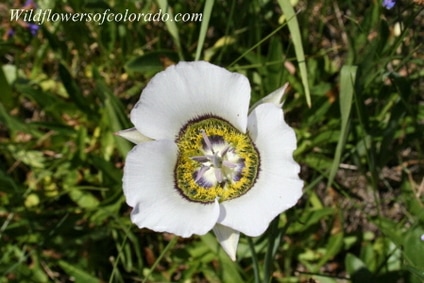
Calichortus gunnisonii
Mariposa Lily
A bold beauty on a slender stem with grass-like leaves. Beloved tulip-shaped, exotically colored gem of the mountains. Collected at 9-10,000' in the grass under Aspen trees.
Can take years to bloom from seed, this will produce a delicious, edible bulb one day. Patience and love are required. Once the bulb is formed it will live many years. Needs 45 days of moist stratification. Plant in fall or winter. Grows to 12". Grows in the Montane in full sun and dappled light.
Perennial
Mariposa Lily
A bold beauty on a slender stem with grass-like leaves. Beloved tulip-shaped, exotically colored gem of the mountains. Collected at 9-10,000' in the grass under Aspen trees.
Can take years to bloom from seed, this will produce a delicious, edible bulb one day. Patience and love are required. Once the bulb is formed it will live many years. Needs 45 days of moist stratification. Plant in fall or winter. Grows to 12". Grows in the Montane in full sun and dappled light.
Perennial
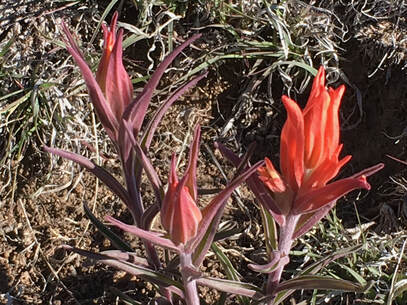 Pic by Penn
Pic by Penn
Castilleja integra
Paintbrush
Bright, glowing color on reddish stemmed plants. Linear leaves on small mounds. Blooms June-Sept and once established, is a long-lived Perennial.
Seeds need moist stratification or plant in fall and winter. Plant very lightly and remember seed to soil contact, press in lightly.
Castilleja is semi-parasitic and needs a host plant. Blue Grama, Fringed Sage, Penstemons, and other native grasses will do the trick.
Be patient! This seed can take 4 weeks to germinate.
Expect blooms in the second or third year.
Dye plant.
Packets come with host plant included.
Paintbrush
Bright, glowing color on reddish stemmed plants. Linear leaves on small mounds. Blooms June-Sept and once established, is a long-lived Perennial.
Seeds need moist stratification or plant in fall and winter. Plant very lightly and remember seed to soil contact, press in lightly.
Castilleja is semi-parasitic and needs a host plant. Blue Grama, Fringed Sage, Penstemons, and other native grasses will do the trick.
Be patient! This seed can take 4 weeks to germinate.
Expect blooms in the second or third year.
Dye plant.
Packets come with host plant included.
 Aspen Paintbrush - Pic by Penn
Aspen Paintbrush - Pic by Penn
Castilleja miniata
Aspen Paintbrush - 9-10,000'
Perennial
I'm walking in the woods, minding my own business when I come across this lovely Paintbrush, tall and willowy and just so beautiful. The dark red blooms rise above the grasses on 10-24" tall, reddish stems, accenting the Aspen trees. They are old friends to me.
I see them along the edge of pine forests and dancing amongst the dappled light of an Aspen grove.
Moist stratify for 30-90 days or plant in fall. Patience is required with all Paintbrush. Worth the wait.
Packet comes with host seed. Limited Quantity.
Aspen Paintbrush - 9-10,000'
Perennial
I'm walking in the woods, minding my own business when I come across this lovely Paintbrush, tall and willowy and just so beautiful. The dark red blooms rise above the grasses on 10-24" tall, reddish stems, accenting the Aspen trees. They are old friends to me.
I see them along the edge of pine forests and dancing amongst the dappled light of an Aspen grove.
Moist stratify for 30-90 days or plant in fall. Patience is required with all Paintbrush. Worth the wait.
Packet comes with host seed. Limited Quantity.

Cercocarpus montanus
Mountain Mahogany - 9,500’
Mountain Mahogany - 9,500’
 Chicory - Pic by Penn
Chicory - Pic by Penn
Cichorium intybus
Wild Chicory
Wild Food, Wild Medicine
Wild Chicory has naturalized it's away around the country, providing food, medicine, forage and nectar for all. It's medicinal properties are so vast and so important I cannot list them all here and as a food it is no slouch either.
Bitter leaves can be blanched and eaten cooked or young leaves can be eaten in spring. Roots are forced in the dark, producing chicons - blanched buds. The root can be dried and roasted and made in to a coffee-like drink. Another survival plant - learn what you can about this amazing beauty. Loved since I was a child.
Wild Chicory
Wild Food, Wild Medicine
Wild Chicory has naturalized it's away around the country, providing food, medicine, forage and nectar for all. It's medicinal properties are so vast and so important I cannot list them all here and as a food it is no slouch either.
Bitter leaves can be blanched and eaten cooked or young leaves can be eaten in spring. Roots are forced in the dark, producing chicons - blanched buds. The root can be dried and roasted and made in to a coffee-like drink. Another survival plant - learn what you can about this amazing beauty. Loved since I was a child.
 Pic by Penn
Pic by Penn
Clematis ligusticifolia
Western White Clematis
6,500’-8,000’
This is that thing that climbs the trees all summer long in the wild, and then in the fall the whole vine is covered with soft puffball seed-heads.
This vine will ramble and climb delightfully so - it is a superstar of the mountains. It grows high and low. Sweet white flower clusters make this a showy vine in spring followed by a gorgeous display in fall.
Perennial
Western White Clematis
6,500’-8,000’
This is that thing that climbs the trees all summer long in the wild, and then in the fall the whole vine is covered with soft puffball seed-heads.
This vine will ramble and climb delightfully so - it is a superstar of the mountains. It grows high and low. Sweet white flower clusters make this a showy vine in spring followed by a gorgeous display in fall.
Perennial
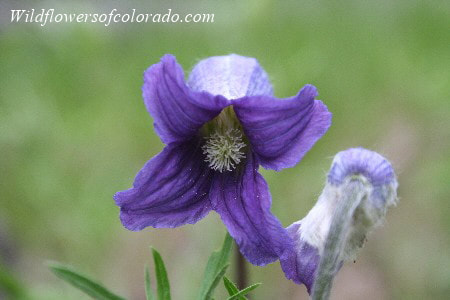 Sugarbowl Clematis
Sugarbowl Clematis
Clematis hirsutissima var. scottii
Sugar Bowl Clematis
Such a flower - nodding heads of purple. Finely cut leaves make a mound with the purple bells rising above. They take patience to get established but then they live a long time.
Drought tolerant and they can take full sun to partial shade. 12" - 18" tall. Seed-heads are beautiful puffballs. I find them in mixed forests in dappled light. A great beauty. Stratify.
Sugar Bowl Clematis
Such a flower - nodding heads of purple. Finely cut leaves make a mound with the purple bells rising above. They take patience to get established but then they live a long time.
Drought tolerant and they can take full sun to partial shade. 12" - 18" tall. Seed-heads are beautiful puffballs. I find them in mixed forests in dappled light. A great beauty. Stratify.
 Pic by Penn
Pic by Penn
Cleome serrulata
Rocky Mountain Bee Plant
I love this plant so much. It grows high and low, along roadsides, in fields, on mountaintops. It can grow 2'-4' tall and 36" wide. It can cover itself in blooms that the pollinators go crazy for. It reseeds itself and once you have it - you always have it. It likes lean soil and blooms from June-Aug. You can moist stratify it for 1-2 months or plant in fall or very early spring - about 1/4" deep. Full sun. Annual.
Rocky Mountain Bee Plant
I love this plant so much. It grows high and low, along roadsides, in fields, on mountaintops. It can grow 2'-4' tall and 36" wide. It can cover itself in blooms that the pollinators go crazy for. It reseeds itself and once you have it - you always have it. It likes lean soil and blooms from June-Aug. You can moist stratify it for 1-2 months or plant in fall or very early spring - about 1/4" deep. Full sun. Annual.
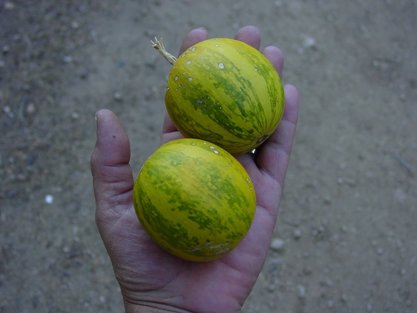 Pic by Penn
Pic by Penn
Curcurbita foetidissima
Buffalo Gourd or Stinking Cucumber
5-6,000’
This is that squash plant growing alongside highways and dirt roads all over hot places in Colorado and the desert southwest. It can take the ever-lovin' heat. In Bob Nolds book, High and Dry, he recommends this plant as a ground cover for impossibly hot and dry places. The leaves are a silvery grey, the flowers are beautiful, it attracts pollinators and it's just, really, really cool.
You can eat the squash when they are young but after they enter the gourd stage, they become bitter. The seeds can be eaten by either roasting or boiling them. They have many uses and the whole plant can be used as animal fodder. It can also be used to make soap.
Adapted to desert and semi-arid conditions. Deep taproot.
Feral Perennial
Buffalo Gourd or Stinking Cucumber
5-6,000’
This is that squash plant growing alongside highways and dirt roads all over hot places in Colorado and the desert southwest. It can take the ever-lovin' heat. In Bob Nolds book, High and Dry, he recommends this plant as a ground cover for impossibly hot and dry places. The leaves are a silvery grey, the flowers are beautiful, it attracts pollinators and it's just, really, really cool.
You can eat the squash when they are young but after they enter the gourd stage, they become bitter. The seeds can be eaten by either roasting or boiling them. They have many uses and the whole plant can be used as animal fodder. It can also be used to make soap.
Adapted to desert and semi-arid conditions. Deep taproot.
Feral Perennial
 Sacred Datura
Sacred Datura
Sacred Datura - Datura wrightii
Perennial - Sometimes Annual - 5,500'
Oh boy I love this plant. I stumbled onto a large, wild patch on a wonderful walk with my love around 5,200'. It can thrive to about 6,000'. It likes the heat, lean soils, full sun. I have seen it grown at higher elevations (7-8,000') and if placed somewhere warm, it will return. If not - you can grow it as an annual each year.
This sprawling plant can make a 4' circle, covered in large, white trumpet flowers, sometimes tinged with purple. Such a stunner!
Best started in winter in pots to set plants out in warm places, you could direct seed. The flower is highly fragrant, the plant, not so much. It is pollinated at night by Hawkmoths.
Native to Colorado. Other names include Jimsonweed and Thornapple.
Remember, Datura is toxic, so be careful when handling it. Give it its own space the thrive. Do not ingest any part of the plant!
Perennial - Sometimes Annual - 5,500'
Oh boy I love this plant. I stumbled onto a large, wild patch on a wonderful walk with my love around 5,200'. It can thrive to about 6,000'. It likes the heat, lean soils, full sun. I have seen it grown at higher elevations (7-8,000') and if placed somewhere warm, it will return. If not - you can grow it as an annual each year.
This sprawling plant can make a 4' circle, covered in large, white trumpet flowers, sometimes tinged with purple. Such a stunner!
Best started in winter in pots to set plants out in warm places, you could direct seed. The flower is highly fragrant, the plant, not so much. It is pollinated at night by Hawkmoths.
Native to Colorado. Other names include Jimsonweed and Thornapple.
Remember, Datura is toxic, so be careful when handling it. Give it its own space the thrive. Do not ingest any part of the plant!

Out Of Stock!
Delphinium occidentale
Larkspur - 10,000’
This flower takes my breath away when I meet it in person in it's natural habitat. It stands 3' tall and rocks out deep blue blooms a-plenty. The elk eat it to get high. I have to fight them for the seed. Not really - but they eat the seed pods with their little lips leaving a stripped stem with one or two pods left. That's what I get. So after they are done partying, I am lucky to find any plant with untouched seed - they know when it's ripe! And no - do not eat the seed - it is toxic.
Delphinium occidentale
Larkspur - 10,000’
This flower takes my breath away when I meet it in person in it's natural habitat. It stands 3' tall and rocks out deep blue blooms a-plenty. The elk eat it to get high. I have to fight them for the seed. Not really - but they eat the seed pods with their little lips leaving a stripped stem with one or two pods left. That's what I get. So after they are done partying, I am lucky to find any plant with untouched seed - they know when it's ripe! And no - do not eat the seed - it is toxic.

Dodecatheon pulchellum
Shooting Star 9,000'
Blooms spring and summer along stream sides, moist meadows, waterways. 4"-10" tall, it often grows in colonies. Magenta, white and yellow shooting stars are a delightful addition to a naturally moist area.
Plant in fall or stratify.
Perennial
 Aspen Fleabane - Pic by Penn
Aspen Fleabane - Pic by Penn
Erigeron speciosa
Aspen Fleabane - 9-10,000'
Perennial
From late Spring through Summer, Aspen Daisy comes on in waves of soft lavender beauty. 8-18" in showy clusters, can grow in sun or half-shade. Often found in mixed forests.
Multiple shades of lavender set against oblong-to-spoon shaped leaves.
Hardy to Zone 3. Plant in Spring or Summer 1/8" deep. Press into soil. Limited Quantity
Aspen Fleabane - 9-10,000'
Perennial
From late Spring through Summer, Aspen Daisy comes on in waves of soft lavender beauty. 8-18" in showy clusters, can grow in sun or half-shade. Often found in mixed forests.
Multiple shades of lavender set against oblong-to-spoon shaped leaves.
Hardy to Zone 3. Plant in Spring or Summer 1/8" deep. Press into soil. Limited Quantity

Eriogonum alatum
Winged Buckwheat
Perennial
A small 2-4"basal rosette of linear red/green leaves sends up a flowering stalk to 6' of small yellow flowers on branching stems. Those flowers eventually turn into deep maroon-red winged seeds - and they last a long time through the winter. Beautiful against a background of snow. The rosette gets more purple and can stay evergreen in winter.
While stratification cannot hurt, pre-treatment it is not necessary. Plant in spring or fall. Grows up high or down low.
Very cool plant.
Winged Buckwheat
Perennial
A small 2-4"basal rosette of linear red/green leaves sends up a flowering stalk to 6' of small yellow flowers on branching stems. Those flowers eventually turn into deep maroon-red winged seeds - and they last a long time through the winter. Beautiful against a background of snow. The rosette gets more purple and can stay evergreen in winter.
While stratification cannot hurt, pre-treatment it is not necessary. Plant in spring or fall. Grows up high or down low.
Very cool plant.

Eutrochium cf. macalatum
Spotted Joe Pye Weed - Perennial - 7,200'
Dark pink flowers in fall, can grow to 4-8', tall and 2-4" wide, hardy to 40 below, full sun to 25% shade, 'architectural', slow spreading clump, butterfly magnet, native to Colorado, medicinal, yellow fall color, beautiful seed-heads, a superb flower. Long-living perennial. Allow to naturalize in a moist, boggy place or along a stream.
Pollinators will come from far and wide. Winter interest. Strong, straight stems with large glorious pink flowers.
Spotted Joe Pye Weed - Perennial - 7,200'
Dark pink flowers in fall, can grow to 4-8', tall and 2-4" wide, hardy to 40 below, full sun to 25% shade, 'architectural', slow spreading clump, butterfly magnet, native to Colorado, medicinal, yellow fall color, beautiful seed-heads, a superb flower. Long-living perennial. Allow to naturalize in a moist, boggy place or along a stream.
Pollinators will come from far and wide. Winter interest. Strong, straight stems with large glorious pink flowers.

Erysimum capitatum
Western Wallflower 7,500-10,000'
Butterflies love it - you will love it too. A perennial
for the mountains, Wallflower is an excellent
addition for color from May to July. Delicate stems
are topped with
bright clusters of yellow, orange and red.
Grow in sun in well drained soil. Barely cover the
seed.
Perennial or Biennial
Western Wallflower 7,500-10,000'
Butterflies love it - you will love it too. A perennial
for the mountains, Wallflower is an excellent
addition for color from May to July. Delicate stems
are topped with
bright clusters of yellow, orange and red.
Grow in sun in well drained soil. Barely cover the
seed.
Perennial or Biennial

Frasera speciosa (Swertia radiata)
Monument Plant - Giant Gentian - 9-10,000'
This plant is an impressive thing to see en masse. For a green and
white flower, there are gorgeous close-up details you have to see to
believe.
The summer of 2015, in northern Colorado, I saw mountainsides of
this thing in all it's glory. A great beauty.
Green Gentian is a monocarpic perennial and will bloom when it's
darn good and ready. It can bloom only once in 20-80 years. Until
then, it will be a beautiful strappy-leafed rosette for decades until it
decides to shoot up a glorious flower stalk.
This plant can also have a mass blooming, how they know - no one
knows - as some plants will sit and wait. Plants communicate and
know just what to do.
Powerful medicine.
Monocarpic Perennial
Monument Plant - Giant Gentian - 9-10,000'
This plant is an impressive thing to see en masse. For a green and
white flower, there are gorgeous close-up details you have to see to
believe.
The summer of 2015, in northern Colorado, I saw mountainsides of
this thing in all it's glory. A great beauty.
Green Gentian is a monocarpic perennial and will bloom when it's
darn good and ready. It can bloom only once in 20-80 years. Until
then, it will be a beautiful strappy-leafed rosette for decades until it
decides to shoot up a glorious flower stalk.
This plant can also have a mass blooming, how they know - no one
knows - as some plants will sit and wait. Plants communicate and
know just what to do.
Powerful medicine.
Monocarpic Perennial
 Gaillardia
Gaillardia
Gaillardia Mix
(Gaillardia aristata, Gaillardia pinnatifida, Gaillardia 'Burgundy')
Blanket Flower - 8,000'
Perennial
Such a reliable flower - hard to beat for non-stop color in a Western flower.
Three kinds of Gaillardia in this mix - they all love the mountains and can take full sun. 12-18" in colorful mounds. Bright color!
(Gaillardia aristata, Gaillardia pinnatifida, Gaillardia 'Burgundy')
Blanket Flower - 8,000'
Perennial
Such a reliable flower - hard to beat for non-stop color in a Western flower.
Three kinds of Gaillardia in this mix - they all love the mountains and can take full sun. 12-18" in colorful mounds. Bright color!
 Pic by Penn
Pic by Penn
Gaillardia aristata
Common Blanket Flower 7-9,000'
Perennial
This is such a forgiving, tough, hardy plant. Pollinator's love it, I love it, you will love it. Native to Colorado and just beautiful with red centers and bright yellow petals. No matter how the season is going, this plant will thrive.
Plant in spring or fall. 12-24" Full sun.
Common Blanket Flower 7-9,000'
Perennial
This is such a forgiving, tough, hardy plant. Pollinator's love it, I love it, you will love it. Native to Colorado and just beautiful with red centers and bright yellow petals. No matter how the season is going, this plant will thrive.
Plant in spring or fall. 12-24" Full sun.
 Pic by Penn
Pic by Penn
Geranium caespitosum James var. fremontii
9,000’
9,000’

Glycyrrhiza lepidota
Wild Licorice - 7,000'
Wild Licorice - 7,000'
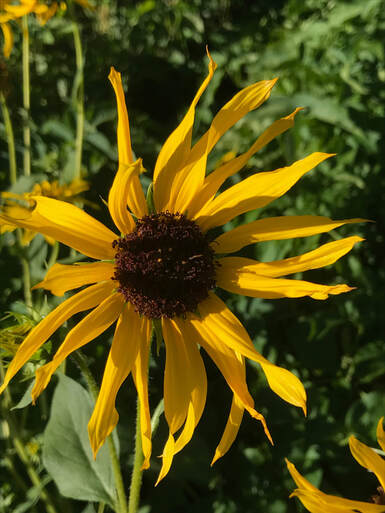 Wild Sunflower - Pic by Penn
Wild Sunflower - Pic by Penn
Helianthus annum
Wild Sunflower
Annual
Along the roadsides in the intermountain west, September is a sight to behold. The wild sunflowers are blooming and it's like driving through a dream. I have so many memories of traveling in fall and marveling at the wild sunflowers - especially during sunset. What a glorious plant. I've loved them all my life, when I lived down below and now up here on the mountain. I never get tired of them.
Plant the seeds 1/4" deep, they love full sun and are hardy to zone 3. Give them their own place to play as they can reach heights of 8', depending on conditions and wind protection. The plant will branch out and cover itself in blooms. Pollinators, hawk-moths, hummingbirds and songbirds all love sunflowers. So do I.
Wild Sunflower
Annual
Along the roadsides in the intermountain west, September is a sight to behold. The wild sunflowers are blooming and it's like driving through a dream. I have so many memories of traveling in fall and marveling at the wild sunflowers - especially during sunset. What a glorious plant. I've loved them all my life, when I lived down below and now up here on the mountain. I never get tired of them.
Plant the seeds 1/4" deep, they love full sun and are hardy to zone 3. Give them their own place to play as they can reach heights of 8', depending on conditions and wind protection. The plant will branch out and cover itself in blooms. Pollinators, hawk-moths, hummingbirds and songbirds all love sunflowers. So do I.
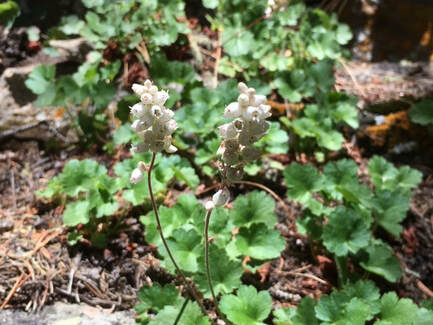 Pic by Penn
Pic by Penn
OUT OF STOCK :(
Heuchera hallii - Front Range Alumroot
Perennial
I find this incredible Heuchera dangling out of crevices in giant boulders, with its lovely basal cluster of leaves topped with beautiful, white, delicate flowers. Rock gardener's rejoice! This is the whitest of the Heucheras, here in Colorado, an absolutely choice plant.
Endemic to south-central Colorado.
Breathtaking.
Heuchera hallii - Front Range Alumroot
Perennial
I find this incredible Heuchera dangling out of crevices in giant boulders, with its lovely basal cluster of leaves topped with beautiful, white, delicate flowers. Rock gardener's rejoice! This is the whitest of the Heucheras, here in Colorado, an absolutely choice plant.
Endemic to south-central Colorado.
Breathtaking.

Holodiscus dumosus
Bush Rock Spirea or Mountain Spray
Shrub - 9,500'
This high-altitude, flowering shrub can grow to 6' X 6' and loves to hang off of cliff faces with spectacular views. I have found myself leaning waaaaayyy out to collect seed. This plant grows easily above 9,000' and below and covers itself in beautiful cluster blooms each spring. Then comes the fuzzy puffy seed heads. This thing is
sensational draping itself down the rocks.
Provide cold stratification for up to 18 weeks.
Bush Rock Spirea or Mountain Spray
Shrub - 9,500'
This high-altitude, flowering shrub can grow to 6' X 6' and loves to hang off of cliff faces with spectacular views. I have found myself leaning waaaaayyy out to collect seed. This plant grows easily above 9,000' and below and covers itself in beautiful cluster blooms each spring. Then comes the fuzzy puffy seed heads. This thing is
sensational draping itself down the rocks.
Provide cold stratification for up to 18 weeks.
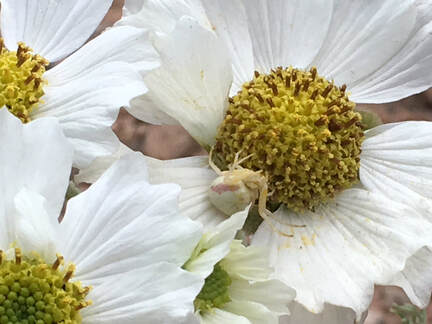 Pic by Penn
Pic by Penn
Hymenopappus newberryi
Wild Cosmos - 9,800'
I love this flower. So drought tolerant, it can grow out of a rock! I find it growing out of cuts on high mountain 4WD roads - with its silvery leaves and white flowers. It is a showy thing in person, one plant can have 3-8 flowers blooming at a time. The bloom time is nice and long and it likes it lean.
Perennial - Native to Colorado
Wild Cosmos - 9,800'
I love this flower. So drought tolerant, it can grow out of a rock! I find it growing out of cuts on high mountain 4WD roads - with its silvery leaves and white flowers. It is a showy thing in person, one plant can have 3-8 flowers blooming at a time. The bloom time is nice and long and it likes it lean.
Perennial - Native to Colorado
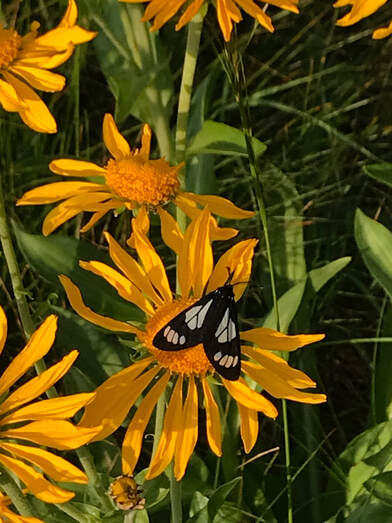 Orange Mountain Daisy - Pic by Penn
Orange Mountain Daisy - Pic by Penn
Hymenoxys hoopsii
Orange Mountain Daisy
Perennial
Gorgeous! Very showy blooms smother 1-3' plants from Summer to Fall. Very impressive, stately plants. Deep yellow to orange color turns heads.
Pollinators love them. The narrow leaves have a notable midvein and the flower petals twist or droop in the most delightful way.
Can tolerate sandy to clayey soils and can grow in full sun to half- shade. Often grows in forest openings and meadows in the montane to subalpine.
Plant 1/4" deep outside in Fall or Spring.
See more pics in the store.
Orange Mountain Daisy
Perennial
Gorgeous! Very showy blooms smother 1-3' plants from Summer to Fall. Very impressive, stately plants. Deep yellow to orange color turns heads.
Pollinators love them. The narrow leaves have a notable midvein and the flower petals twist or droop in the most delightful way.
Can tolerate sandy to clayey soils and can grow in full sun to half- shade. Often grows in forest openings and meadows in the montane to subalpine.
Plant 1/4" deep outside in Fall or Spring.
See more pics in the store.
 Pic by Penn
Pic by Penn
Ipomea leptophylla
Bush Morning Glory 5,000'
Oh what a plant. "Manroot". Slow growing perennial with gorgeous purple-pink blooms that open in the morning. The plant is smothered in them. The root can get as big as a man's arm and several feet deep. The plants can live for many, many years. Patience is required to get them established. This plant likes it lean and sunny.
Bush Morning Glory 5,000'
Oh what a plant. "Manroot". Slow growing perennial with gorgeous purple-pink blooms that open in the morning. The plant is smothered in them. The root can get as big as a man's arm and several feet deep. The plants can live for many, many years. Patience is required to get them established. This plant likes it lean and sunny.
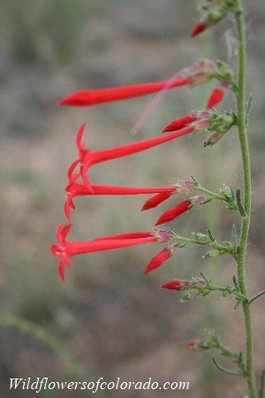
Ipomopsis aggregata
Skyrocket Gilia - Fairy Trumpet - 8,000’
Skyrocket Gilia - Fairy Trumpet - 8,000’

Iris missouriensis
Blue Flag - 9,600’
Blue Flag - 9,600’
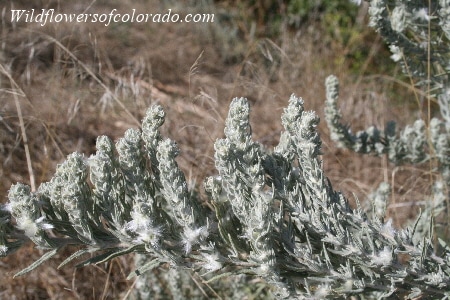 Winterfat
Winterfat
Krascheninnikovia lanata
Winterfat - 8,000’
Winterfat - 8,000’
 Gayfeather
Gayfeather
Liatris punctata
Dotted Blazingstar 7 – 8,000’
(AKA Gayfeather)
Dotted Blazingstar 7 – 8,000’
(AKA Gayfeather)
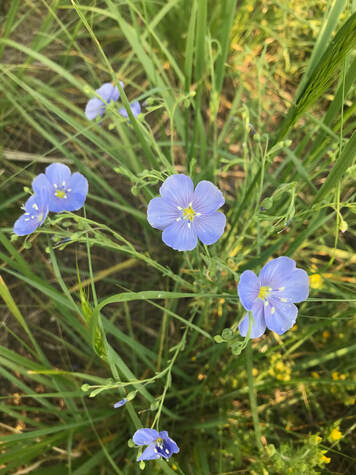 Blue Flax - Pic by Penn
Blue Flax - Pic by Penn
Linum lewisii
Blue Flax - 8,000'
Perennial
Haven't you just loved this thing all of your life? Cord says they greet him in the morning - as if they are not greeting the rest of us too! :) While watering it's hard to not notice them in the morning light. The blooms fade by mid-day. En masse they are a heavenly thing to see.
Plants grow 16-20" on graceful, nodding stems that face upward in bloom. Such a humble beauty - and plays nice with others. You cannot have too much Blue Flax, it has a wonderful way of finding perfect places to grow. It grows in a fine clump with multitudes of slender stems rising above. It can stand drought, lean soils and grows up high and down low. It prefers well draining soil. Collected around 8,000'
Plant in late fall to very early spring 1/8". Enjoy for years.
Medicine, Fiber, Food
Blue Flax - 8,000'
Perennial
Haven't you just loved this thing all of your life? Cord says they greet him in the morning - as if they are not greeting the rest of us too! :) While watering it's hard to not notice them in the morning light. The blooms fade by mid-day. En masse they are a heavenly thing to see.
Plants grow 16-20" on graceful, nodding stems that face upward in bloom. Such a humble beauty - and plays nice with others. You cannot have too much Blue Flax, it has a wonderful way of finding perfect places to grow. It grows in a fine clump with multitudes of slender stems rising above. It can stand drought, lean soils and grows up high and down low. It prefers well draining soil. Collected around 8,000'
Plant in late fall to very early spring 1/8". Enjoy for years.
Medicine, Fiber, Food

Lupinus perennis
Wild Lupine
Northern Wisconsin
If you ever get to Northern Wisconsin in summer - anywhere near the Big Lake, you will see Lupine as far as the eye can see. I have family ties there and my earliest memories are of those Lupines. It wasn't until I was in this business when I remembered that the flowers from my childhood were Lupine - and Daisies. I had a chance to harvest some seed last summer and I am thrilled to offer them. The things dreams are made of.
Plant seeds 1/2" deep in spring. Germination aids: Scarification, inoculation, moist stratification for 10 days. Seeds are poisonous. Plants grow a deep taproot, legumes fix nitrogen, and is a host plant for the Elf Moth, (Microtia elva) and the Frosted Elfin Moth, (Callophrys irus). Highly adaptable.

Machaeranthera bigelovii
Tall Tansy Aster – biennial – 8,000’
Tall Tansy Aster – biennial – 8,000’
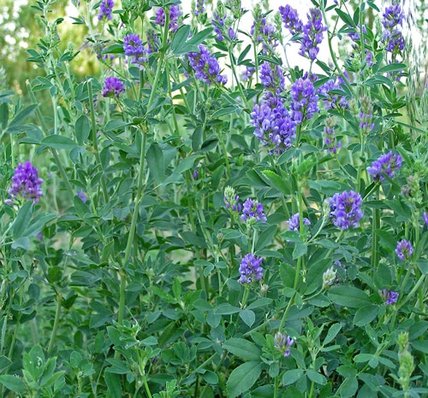
Medicago sativa
Alfalfa – 5,000’ and 8,000’
Alfalfa – 5,000’ and 8,000’

Mentzelia decapetala
Evening Star - 6,000'
(aka Blazing Star)
Evening Star - 6,000'
(aka Blazing Star)

Mentzelia nuda
Bractless Evening Star - 8,000'
(AKA Bractless Blazingstar)
Panayoti calls them "Steppe Stars" - he says they are not Blazing Stars (the common name for Liatris), more like 'Evening Stars'...
This plant smothers itself in blooms on a 1-3' plant. I find it growing from 5-8000'. Sometimes my gulley has an exceptional year and it covers the banks, sending up a lovely scent in the evening. They open in the afternoon and explode with these glorious creamy flowers. The leaves are sticky - it is sometimes called, 'stickleaf', and is supposed to have inspired Velcro. The leaves have barbed hairs and can stick to your clothes.
This plant is Biennial or Perennial and has years where they are everywhere, and then not so much - common for some of our most intrepid natives. They can make a wonderful dome on good years, or only shoot up a few branches, but when they open, you will notice.
They bloom July - September. You can pre-soak the seeds to aid in germination. Allow it to reseed once you have it and then you'll be happy forever more.
Bractless Evening Star - 8,000'
(AKA Bractless Blazingstar)
Panayoti calls them "Steppe Stars" - he says they are not Blazing Stars (the common name for Liatris), more like 'Evening Stars'...
This plant smothers itself in blooms on a 1-3' plant. I find it growing from 5-8000'. Sometimes my gulley has an exceptional year and it covers the banks, sending up a lovely scent in the evening. They open in the afternoon and explode with these glorious creamy flowers. The leaves are sticky - it is sometimes called, 'stickleaf', and is supposed to have inspired Velcro. The leaves have barbed hairs and can stick to your clothes.
This plant is Biennial or Perennial and has years where they are everywhere, and then not so much - common for some of our most intrepid natives. They can make a wonderful dome on good years, or only shoot up a few branches, but when they open, you will notice.
They bloom July - September. You can pre-soak the seeds to aid in germination. Allow it to reseed once you have it and then you'll be happy forever more.

Mimulus guttatus
Common Monkey Flower – 9,800’
Such a little beauty. You will find this in the high mountain streams, in the 'babbling brook', even the water running along the steep mountain road. Delightful, small mounds with yellow monkey faces decorate any waterway.
Plant it near any water, naturally moist places, or right along the creek. Sweet.
Plant on the surface, keep moist through germination.
Common Monkey Flower – 9,800’
Such a little beauty. You will find this in the high mountain streams, in the 'babbling brook', even the water running along the steep mountain road. Delightful, small mounds with yellow monkey faces decorate any waterway.
Plant it near any water, naturally moist places, or right along the creek. Sweet.
Plant on the surface, keep moist through germination.

Mirabilis multiflora
Colorado Four O’Clock - 6,500’
I grew up in Pueblo West, Colorado and right up against our house and in our driveway, grew the Four O'Clock. There was a huge one under a Juniper Tree, which is where you will find them far and wide. They like each other. Every afternoon at Four O'Clock, as the desert heat just began to wane, the sprawling glossy-leafed plant would burst forth in a spectacular display of purple, like you've never seen. It isn't just the color, it's that sunset in the desert is a thing to behold, spreading an apricot light over the land that seems to attach to your skin. When that happens, Four O'Clock gleams and burns in the apricot light, just coming alive for those brief moments. It's an incredible sight.
Plant in spring or fall or stratify and try it in pots too. Expect 2-3 weeks for germination. Direct seed it under or just outside of a Juniper Tree or in a hot, lean spot. I don't find it much higher than 7,000 - 7,500 ft. It likes the heat. Long-lived Perennial.
Colorado Four O’Clock - 6,500’
I grew up in Pueblo West, Colorado and right up against our house and in our driveway, grew the Four O'Clock. There was a huge one under a Juniper Tree, which is where you will find them far and wide. They like each other. Every afternoon at Four O'Clock, as the desert heat just began to wane, the sprawling glossy-leafed plant would burst forth in a spectacular display of purple, like you've never seen. It isn't just the color, it's that sunset in the desert is a thing to behold, spreading an apricot light over the land that seems to attach to your skin. When that happens, Four O'Clock gleams and burns in the apricot light, just coming alive for those brief moments. It's an incredible sight.
Plant in spring or fall or stratify and try it in pots too. Expect 2-3 weeks for germination. Direct seed it under or just outside of a Juniper Tree or in a hot, lean spot. I don't find it much higher than 7,000 - 7,500 ft. It likes the heat. Long-lived Perennial.
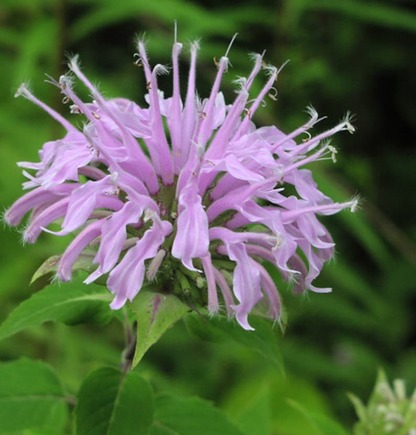 Wild Bergamot
Wild Bergamot
Monarda fistulosa
Wild Bergamot
Perennial
Love me some Bee Balm. This plant provides so much love to humans and critters, it's beautiful, fragrant, long-lived, long-blooming, provides nectar, forage and much, much medicine. Look up it's many gifts - and the next time you have Bergamot Tea, it will feel even better to drink it in. Indigenous Peoples used this plant in many applications as food and medicine. Loved by humans for millennia.
Grows up to 3' with delightful, showy pink bed-head looking flowers. Pollinators and hummingbirds adore this plant and it is a host for many beautiful insects. Blooms in June and July and appreciates full sun.
Can take lean soils and low water once established.
Hardy to Zone 3.
Cool moist stratify for 45 days or plant in fall to early
spring.
Plant on the surface and barely cover the seed. Press
in for good seed-to-soil-contact.
Wild Bergamot
Perennial
Love me some Bee Balm. This plant provides so much love to humans and critters, it's beautiful, fragrant, long-lived, long-blooming, provides nectar, forage and much, much medicine. Look up it's many gifts - and the next time you have Bergamot Tea, it will feel even better to drink it in. Indigenous Peoples used this plant in many applications as food and medicine. Loved by humans for millennia.
Grows up to 3' with delightful, showy pink bed-head looking flowers. Pollinators and hummingbirds adore this plant and it is a host for many beautiful insects. Blooms in June and July and appreciates full sun.
Can take lean soils and low water once established.
Hardy to Zone 3.
Cool moist stratify for 45 days or plant in fall to early
spring.
Plant on the surface and barely cover the seed. Press
in for good seed-to-soil-contact.
 Pony Beebalm - Pic by Penn
Pony Beebalm - Pic by Penn
Monarda pectinata
Pony Beebalm - 8,000’
Annual
This beautiful balm showed up here this year in a glorious en masse display all over our bottomland, after laying low for many years. This is the thing with Colorado and other mountain states, no two years are alike. Besides the drought we've been experiencing, conditions need to be right for native plants - if they are not, they will lay in wait until they are.
But burst they did and I was so thrilled - they were buzz, buzz, buzzing with pollinators! Color is white to pink to violet. Seed-heads often turn to a dark maroon. Plus they smell minty, they play well with others - just lovely. As with all the mint family - Pony Beebalm has square stems.
It's good medicine, and a good friend to other plants. Good for colds of course.
Grows 6-18" depending on rainfall, and can make a nice sized clump. While it grows up here at 8,000', it is often found from the plains to the Piñon/Juniper foothills.
Plant in fall, barely cover the seed or provide a cool, moist stratification for 45 days.
Pony Beebalm - 8,000’
Annual
This beautiful balm showed up here this year in a glorious en masse display all over our bottomland, after laying low for many years. This is the thing with Colorado and other mountain states, no two years are alike. Besides the drought we've been experiencing, conditions need to be right for native plants - if they are not, they will lay in wait until they are.
But burst they did and I was so thrilled - they were buzz, buzz, buzzing with pollinators! Color is white to pink to violet. Seed-heads often turn to a dark maroon. Plus they smell minty, they play well with others - just lovely. As with all the mint family - Pony Beebalm has square stems.
It's good medicine, and a good friend to other plants. Good for colds of course.
Grows 6-18" depending on rainfall, and can make a nice sized clump. While it grows up here at 8,000', it is often found from the plains to the Piñon/Juniper foothills.
Plant in fall, barely cover the seed or provide a cool, moist stratification for 45 days.

Oenothera biennis
Evening Primrose - 8,000’
Evening Primrose - 8,000’

Pedicularis bracteosa - 9,800'
Fern Leaf Lousewort (Bracted Lousewort)
Up to 3" tall, Bracted Lousewort is a beautiful, sturdy-stemmed yellow flower of the woods. Fern-like foliage shoots up beautiful blooms from June to August.
Grows on slopes or moist meadows. I find it from full sun to dappled shade.
Perennial
Fern Leaf Lousewort (Bracted Lousewort)
Up to 3" tall, Bracted Lousewort is a beautiful, sturdy-stemmed yellow flower of the woods. Fern-like foliage shoots up beautiful blooms from June to August.
Grows on slopes or moist meadows. I find it from full sun to dappled shade.
Perennial

Pedicularis groenlandica
Elephant Head - 9,700’
Elephant Head - 9,700’
 Photo by Penn
Photo by Penn
Penstemon auriberbis
Fuzzy Tongue Penstemon - 7,888'
Waves of soft, lavender clusters graced the mountains this year, making me pull the car over and get out. Bright golden-bearded throats are just beautiful up close. Grows 4"-12" and has narrow, linear leaves.
Claude Barr called it a 'rare jewel'. I found it stunning with the lavender and orange-yellow contrast. Native to the Arkansas River Valley. I see it
at 5-6000' and also at 7,888'.
Great rock garden plant. Sweet color. Plant in fall or stratify in a moist medium for 30 days. Cover lightly with sand.
Fuzzy Tongue Penstemon - 7,888'
Waves of soft, lavender clusters graced the mountains this year, making me pull the car over and get out. Bright golden-bearded throats are just beautiful up close. Grows 4"-12" and has narrow, linear leaves.
Claude Barr called it a 'rare jewel'. I found it stunning with the lavender and orange-yellow contrast. Native to the Arkansas River Valley. I see it
at 5-6000' and also at 7,888'.
Great rock garden plant. Sweet color. Plant in fall or stratify in a moist medium for 30 days. Cover lightly with sand.
 Photo by Penn
Photo by Penn
Penstemon barbatus
Scarlet Bugler Penstemon - 8-9,000'
Scarlet red flowers adorn straight, upright reddish/purple stems that can reach 4'. Gracing the Rockies in June and July, this beauty has no problem growing up high. Long lasting flowers grow out of sandy, rocky road cuts, amongst rocky crevices and along roadsides. Can take drought conditions although if there is no snow in winter, water plants once a month.
Plant in fall or moist-stratify for 1-2 months. Barely cover the seed. No chocolate cake soil! This plant likes it lean - full sun is best but I see it with some shade along forests. Don't overwater.
Perennial
Scarlet Bugler Penstemon - 8-9,000'
Scarlet red flowers adorn straight, upright reddish/purple stems that can reach 4'. Gracing the Rockies in June and July, this beauty has no problem growing up high. Long lasting flowers grow out of sandy, rocky road cuts, amongst rocky crevices and along roadsides. Can take drought conditions although if there is no snow in winter, water plants once a month.
Plant in fall or moist-stratify for 1-2 months. Barely cover the seed. No chocolate cake soil! This plant likes it lean - full sun is best but I see it with some shade along forests. Don't overwater.
Perennial
 Brandegeei's Penstemon - Pic by Penn
Brandegeei's Penstemon - Pic by Penn
Penstemon brandegeei
Brandegei's Penstemon
Perennial
Such color! Like you've never seen - this plant is a knock-out! The colors range from the deepest blue to hot pink and darker wine hues. But mostly it's this incredible blue color. The leaves are widely arrow-shaped and clasp the thick stems. They have a groovy crinkle along the edge.
It can grow to 3'! Strong stems and thick leaves are a fabulous glossy gray/green color. Mature plants branch out multiple stems in an incredible display.
Rocky, gravelly, well draining soil is what it likes. I find it up high from 9-10,000'. It can take full sun and part shade - I see it on rocky slopes, mixed forests, road cuts and open fields.
1-2 month stratification required or plant in fall or early winter. Barely cover the seed with sand and press in.
Brandegei's Penstemon
Perennial
Such color! Like you've never seen - this plant is a knock-out! The colors range from the deepest blue to hot pink and darker wine hues. But mostly it's this incredible blue color. The leaves are widely arrow-shaped and clasp the thick stems. They have a groovy crinkle along the edge.
It can grow to 3'! Strong stems and thick leaves are a fabulous glossy gray/green color. Mature plants branch out multiple stems in an incredible display.
Rocky, gravelly, well draining soil is what it likes. I find it up high from 9-10,000'. It can take full sun and part shade - I see it on rocky slopes, mixed forests, road cuts and open fields.
1-2 month stratification required or plant in fall or early winter. Barely cover the seed with sand and press in.
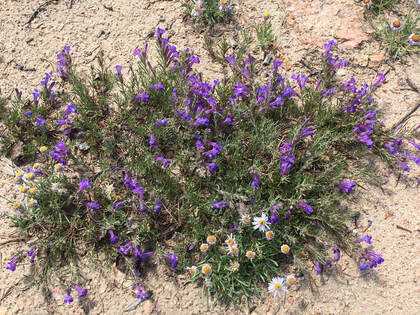 Pic by Penn
Pic by Penn
OUT OF STOCK!
Penstemon crandallii - (P. caespitosus)
Mat Penstemon
Collected at 9,500'
This tough, drought tolerant, altitude adapted Penstemon can grow right out of the road base. It can cover the ground with hundreds of these sweet little mounds of color. Great for rock gardens or places with lean soil. Grows 1-6". 30 days moist stratification or plant in fall. Barely cover the seed with sand.
Limited Quantity
Penstemon crandallii - (P. caespitosus)
Mat Penstemon
Collected at 9,500'
This tough, drought tolerant, altitude adapted Penstemon can grow right out of the road base. It can cover the ground with hundreds of these sweet little mounds of color. Great for rock gardens or places with lean soil. Grows 1-6". 30 days moist stratification or plant in fall. Barely cover the seed with sand.
Limited Quantity
 Pic by Penn
Pic by Penn
Penstemon palmeri - 6,700'
Palmer's Penstemon
Perennial
Oh I love this thing. When you see it in the wild you just stand there and gape for a while. Absolutely stunning, showy, gorgeous, and evergreen! The rosette is a glossy silvery green with toothed edges, you could spot it anywhere. The large, pink flowers are scented and stand from 3-6' tall.
Allow to reseed to create a stand. I collect it at 6,800' and it doesn't seem to naturalize above 7,500'. Higher elevations - it is worth growing as an annual. Wow.
30-45 days moist stratification or plant in fall. Barely cover the seed with sand.
Palmer's Penstemon
Perennial
Oh I love this thing. When you see it in the wild you just stand there and gape for a while. Absolutely stunning, showy, gorgeous, and evergreen! The rosette is a glossy silvery green with toothed edges, you could spot it anywhere. The large, pink flowers are scented and stand from 3-6' tall.
Allow to reseed to create a stand. I collect it at 6,800' and it doesn't seem to naturalize above 7,500'. Higher elevations - it is worth growing as an annual. Wow.
30-45 days moist stratification or plant in fall. Barely cover the seed with sand.

Penstemon strictus
Rocky Mountain Penstemon - 7,888'
Perennial
1-3' of beauty. Straight, erect stems rise above lovely rosettes. Easy to grow, allow to reseed for a lifetime of Penstemon.
Prefers lean soils with good drainage, can take full sun. A staple in the mountain garden.
14-45 day moist stratification - barely cover the seed with sand. 21 days to germinate.
Rocky Mountain Penstemon - 7,888'
Perennial
1-3' of beauty. Straight, erect stems rise above lovely rosettes. Easy to grow, allow to reseed for a lifetime of Penstemon.
Prefers lean soils with good drainage, can take full sun. A staple in the mountain garden.
14-45 day moist stratification - barely cover the seed with sand. 21 days to germinate.
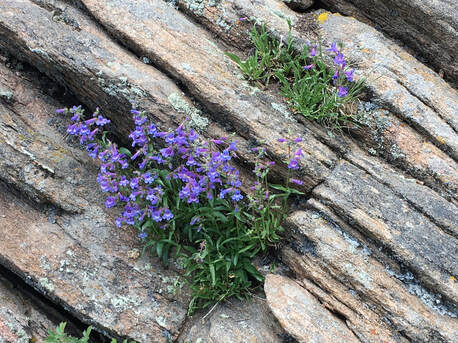 Pic by Penn
Pic by Penn
Blue Mist Penstemon - 9,500'
Penstemon virens - Perennial
Seeing this in blue waves across a mountain meadow is a thing to behold. It can cover road cuts, play amongst the rocks or grow in boulder crevices. It ranges from a dark blue to blue/lavender on short, compact plants with glossy leaves.
Blooms July and August. Grows from 6-12" tall, the higher you are in elevation, the shorter it grows. Reliable. Charming.
Moist stratify for 30-60 days or plant in fall.
Barely cover the seed with sand.
Penstemon virens - Perennial
Seeing this in blue waves across a mountain meadow is a thing to behold. It can cover road cuts, play amongst the rocks or grow in boulder crevices. It ranges from a dark blue to blue/lavender on short, compact plants with glossy leaves.
Blooms July and August. Grows from 6-12" tall, the higher you are in elevation, the shorter it grows. Reliable. Charming.
Moist stratify for 30-60 days or plant in fall.
Barely cover the seed with sand.
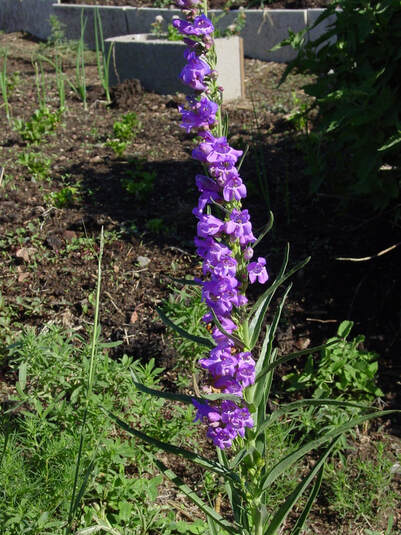 Pic by Penn
Pic by Penn
Penstemon virgatus
Wandbloom Penstemon - 8,000'
8-24" of striking color on straight stems with linear leaves, this almost wine to lavender colored Penstemon does the trick for quiet beauty amongst the trees in my garden. It grows high, lean and even in half shade.
I can't get enough of Penstemon's and this one grows on this mountain at 8,120.
30-60 days of moist stratification or plant in fall. Cover lightly with sand.
Limited Quantity
Wandbloom Penstemon - 8,000'
8-24" of striking color on straight stems with linear leaves, this almost wine to lavender colored Penstemon does the trick for quiet beauty amongst the trees in my garden. It grows high, lean and even in half shade.
I can't get enough of Penstemon's and this one grows on this mountain at 8,120.
30-60 days of moist stratification or plant in fall. Cover lightly with sand.
Limited Quantity
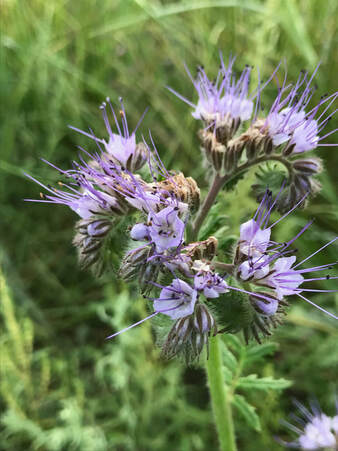 Bee's Friend - Pic by Penn
Bee's Friend - Pic by Penn
Phacelia tanacetifolia
Bee's Friend or Fiddleneck - 8,000’
Annual
Easy-to grow annual will bring in the bees. Lovely lacy leaves adorned with unfurling lavender flowers the pollinators go crazy for. Gotta have it every year. I let it reseed and pop up here and there. Not invasive, just willing.
Plant the seed 1/8" and press in gently.
Bee's Friend or Fiddleneck - 8,000’
Annual
Easy-to grow annual will bring in the bees. Lovely lacy leaves adorned with unfurling lavender flowers the pollinators go crazy for. Gotta have it every year. I let it reseed and pop up here and there. Not invasive, just willing.
Plant the seed 1/8" and press in gently.
 Broadleaf Plantain
Broadleaf Plantain
Plantago major
Broadleaf Plantain - 9,000'
Wild food, wild medicine. Known to Indigenous Peoples as "White Man's Footprint" as it was brought by colonists. Oval-shaped leaves with green/brown spikey minuscule flowers.
This plant can save your life if you are lost in the woods or wounded. It is one of a handful of plants I teach my sons to recognize as a survival plant for food and medicine. High in Calcium, Vitamins A, C and K.
You can eat young, fresh leaves in spring but later they need to be cooked. Chock full of nutrients and incredible healing properties.
Plantain grows all over the world.
Broadleaf Plantain - 9,000'
Wild food, wild medicine. Known to Indigenous Peoples as "White Man's Footprint" as it was brought by colonists. Oval-shaped leaves with green/brown spikey minuscule flowers.
This plant can save your life if you are lost in the woods or wounded. It is one of a handful of plants I teach my sons to recognize as a survival plant for food and medicine. High in Calcium, Vitamins A, C and K.
You can eat young, fresh leaves in spring but later they need to be cooked. Chock full of nutrients and incredible healing properties.
Plantain grows all over the world.
 Woolly Plantain - Pic by Penn
Woolly Plantain - Pic by Penn
Plantago patagonica
Woolly Plantain - 8,000'
Annual - Herbaceous
This sweet tiny plant showed up here last year, in our bottomland meadow along the deep gully that runs through this land. I thought it was delightful, even charming. It seems tiny plant people would love it though I hear in can reseed aggressively down below and in the right conditions. It typically doesn't grow at 8,120' - but there it was - such a little beauty in a small, lovely stand.
Linear leaves branch from an upright basal rosette. Inflorescence topped with a dense, woolly flower spike. Tiny flowers are white. Fuzzy white hairs all over create an absolute glow in the sunshine. Grows up to 7" - Spring blooming. Can take lean, well drained soil but grows in most of the country.
I collect and tend wild plants carefully. There is only a small amount
of this seed so the weight will be small and it won't last long.
Medicinal, ceremonial.
Limited quantity.
Woolly Plantain - 8,000'
Annual - Herbaceous
This sweet tiny plant showed up here last year, in our bottomland meadow along the deep gully that runs through this land. I thought it was delightful, even charming. It seems tiny plant people would love it though I hear in can reseed aggressively down below and in the right conditions. It typically doesn't grow at 8,120' - but there it was - such a little beauty in a small, lovely stand.
Linear leaves branch from an upright basal rosette. Inflorescence topped with a dense, woolly flower spike. Tiny flowers are white. Fuzzy white hairs all over create an absolute glow in the sunshine. Grows up to 7" - Spring blooming. Can take lean, well drained soil but grows in most of the country.
I collect and tend wild plants carefully. There is only a small amount
of this seed so the weight will be small and it won't last long.
Medicinal, ceremonial.
Limited quantity.
 Red Whisker Clammyweed
Red Whisker Clammyweed
Polanisia dodecandra
Redwhisker Clammyweed
Annual
Oooh this is a fun plant. A cousin to wild Cleome, this annual easy-to-grow plant comes with fabulous red 'whiskers' and upright seed pods.
Plant in fall to early spring 1/4" deep. Grows up to 2' tall and is quite striking in bloom. White flowers with long red
stamens make a gorgeous contrast.
It likes full sun, gravelly or sandy soil and I find it at
around 6,700' in the Rockies.
It's sticky to the touch and pollinators love it. Allow it
to reseed and dance around with the wild Cleome.
Redwhisker Clammyweed
Annual
Oooh this is a fun plant. A cousin to wild Cleome, this annual easy-to-grow plant comes with fabulous red 'whiskers' and upright seed pods.
Plant in fall to early spring 1/4" deep. Grows up to 2' tall and is quite striking in bloom. White flowers with long red
stamens make a gorgeous contrast.
It likes full sun, gravelly or sandy soil and I find it at
around 6,700' in the Rockies.
It's sticky to the touch and pollinators love it. Allow it
to reseed and dance around with the wild Cleome.
 Self-Heal
Self-Heal
Prunella vulgaris
Self-Heal - 9,000'
Perennial Herb
Self-Heal or 'Heal-All' is an edible herb well-known for it's medicinal properties and health benefits.
Eat young leaves raw in salad or cook as a potherb. Aerial parts of the plant can be dried, powdered and infused for a dose of Vitamins A, C and K.
Easy to grow.
Self-Heal - 9,000'
Perennial Herb
Self-Heal or 'Heal-All' is an edible herb well-known for it's medicinal properties and health benefits.
Eat young leaves raw in salad or cook as a potherb. Aerial parts of the plant can be dried, powdered and infused for a dose of Vitamins A, C and K.
Easy to grow.

Pterospora andromedea
Pinedrops - 10,000’
Perennial
I love running into this plant in the deep woods. It grows under pines and in mixed forests, poking up amongst the greenery. Lacking chlorophyll, this mysterious plant has a symbiotic relationship with mycorrhizal fungi. This association is with only a handful of fungi in the genus Rhizopogon - some commonly known as 'False Truffles'.
Needless to say, these need to grow where mushrooms grow.
This plant is very cold-hardy. Allow to naturalize.
For best results, plant in fall or cold-stratify.
Pinedrops - 10,000’
Perennial
I love running into this plant in the deep woods. It grows under pines and in mixed forests, poking up amongst the greenery. Lacking chlorophyll, this mysterious plant has a symbiotic relationship with mycorrhizal fungi. This association is with only a handful of fungi in the genus Rhizopogon - some commonly known as 'False Truffles'.
Needless to say, these need to grow where mushrooms grow.
This plant is very cold-hardy. Allow to naturalize.
For best results, plant in fall or cold-stratify.

Ratibida columnifera
Red Mexican Hat - 7,888’
Red Mexican Hat - 7,888’

Ratibida columnifera
Yellow Mexican Hat - 7,888’
Yellow Mexican Hat - 7,888’
 Mexican Hat - Mixed Colors
Mexican Hat - Mixed Colors
Ratibida columnifera
Mexican Hat - Mixed Colors - 7,888'
Perennial
A beloved Prairie-to-Mountain plant, Ratibida is easy to grow and provides bold colors. From bright yellow to fire-orange-red, you can also expect bi-colors. Will naturalize in waves of carefree plants. Grow in wildflower meadows, hot places, garden borders, along fences and anywhere you want to attract pollinators.
Plant in spring or summer and let it do it's thing. Blooms from May to July and can grow to 2'. Plant the seed 1/16 - 1/8" deep.
Mexican Hat - Mixed Colors - 7,888'
Perennial
A beloved Prairie-to-Mountain plant, Ratibida is easy to grow and provides bold colors. From bright yellow to fire-orange-red, you can also expect bi-colors. Will naturalize in waves of carefree plants. Grow in wildflower meadows, hot places, garden borders, along fences and anywhere you want to attract pollinators.
Plant in spring or summer and let it do it's thing. Blooms from May to July and can grow to 2'. Plant the seed 1/16 - 1/8" deep.

Rosa woodsii
Wild Rose

Rudbeckia laciniata
Cutleaf Coneflower 9,000'
Oh mighty one, I have to reach up for your seeds. This beauty can grow 24-72" in dappled light. I find it near waterways, dry or wet. Beautiful cut-leaf foliage, with bright yellow sunny coneflowers with brown centers. Peak of bloom is July, can grow in sand and loam and rocky places - although it will grow taller near water. Absolutely stunning!
Plant in fall to early spring or cold stratify in a moist medium for a month before planting.
Perennial
Cutleaf Coneflower 9,000'
Oh mighty one, I have to reach up for your seeds. This beauty can grow 24-72" in dappled light. I find it near waterways, dry or wet. Beautiful cut-leaf foliage, with bright yellow sunny coneflowers with brown centers. Peak of bloom is July, can grow in sand and loam and rocky places - although it will grow taller near water. Absolutely stunning!
Plant in fall to early spring or cold stratify in a moist medium for a month before planting.
Perennial
 Lanceleaf Figwort - Pic by Penn
Lanceleaf Figwort - Pic by Penn
Scrophularia lanceolata
Lanceleaf Figwort - 9,000'
Perennial
Such a groovy plant - I love this thing! It sneaks up on me, while I'm often looking down for cool plants, I finally realize it's eye to eye but it's so ethereal and delicate that I don't notice it until I am upon it! This figwort grows from 3-5'! It is unassuming at first but the closer you look, the more fascinating it becomes.
The flowers are green, yellow, brown and a little blush of red. Funnels, urns, mouths, you name it, these words are used to describe the unusual flowers.
It grows in full sun to full shade and can tolerate moist to dry soils. I usually find it growing in a low place, taking advantage of a little more water. Sow seeds on the surface, they need light to germinate.
This plant is NECTAR-RICH, everybody from bees to hummingbirds will zoom it ecstatically. It blooms from May-July. Very hardy, perfect for the mountain garden. Medicinal.
Lanceleaf Figwort - 9,000'
Perennial
Such a groovy plant - I love this thing! It sneaks up on me, while I'm often looking down for cool plants, I finally realize it's eye to eye but it's so ethereal and delicate that I don't notice it until I am upon it! This figwort grows from 3-5'! It is unassuming at first but the closer you look, the more fascinating it becomes.
The flowers are green, yellow, brown and a little blush of red. Funnels, urns, mouths, you name it, these words are used to describe the unusual flowers.
It grows in full sun to full shade and can tolerate moist to dry soils. I usually find it growing in a low place, taking advantage of a little more water. Sow seeds on the surface, they need light to germinate.
This plant is NECTAR-RICH, everybody from bees to hummingbirds will zoom it ecstatically. It blooms from May-July. Very hardy, perfect for the mountain garden. Medicinal.
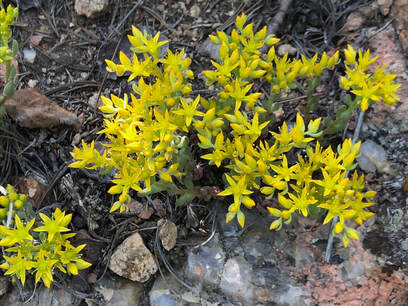 Yellow Stonecrop - Pic by Penn
Yellow Stonecrop - Pic by Penn
Sedum lanceolatum
Yellow Stonecrop
Perennial
From the Foothills to the Alpine, this tiny yet showy succulent can light up a rocky mountainside with it's bright color. To 4", this fleshy leafed beauty changes it's green stems and leaves into a deep maroon in fall. The tiny star-like yellow flowers gain a reddish tinge. Yes, this is a perfect rock garden plant, I see it nestled amongst the rocks, even on road cuts, rock outcroppings and in rocky fields. It like good drainage, coarse
or sandy loam and full sun. Easy to grow from seed or by little
plantlets growing on the stem that drop to the ground and take
root. Let it make a stand!
Plant in spring or summer, barely cover the tiny seed.
Collected from 9-10,000'.
Yellow Stonecrop
Perennial
From the Foothills to the Alpine, this tiny yet showy succulent can light up a rocky mountainside with it's bright color. To 4", this fleshy leafed beauty changes it's green stems and leaves into a deep maroon in fall. The tiny star-like yellow flowers gain a reddish tinge. Yes, this is a perfect rock garden plant, I see it nestled amongst the rocks, even on road cuts, rock outcroppings and in rocky fields. It like good drainage, coarse
or sandy loam and full sun. Easy to grow from seed or by little
plantlets growing on the stem that drop to the ground and take
root. Let it make a stand!
Plant in spring or summer, barely cover the tiny seed.
Collected from 9-10,000'.
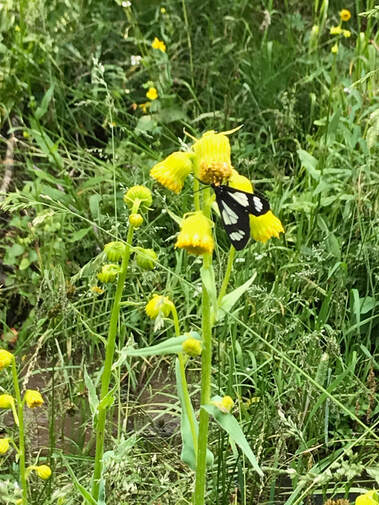 Nodding Ragwort
Nodding Ragwort
Senecio bigelovii
Nodding Ragwort
Perennial
I love this thing - have admired it for many years. It is unassumingly beautiful. Yellow, rayless, nodding flower heads stand up to 3' tall on erect stems arranged in a narrow branched cluster. It blooms from July to September and likes moist meadows and bottomland. It grows from way down low to way up high - so willing!
This plant will do fine in a garden - note that it needs water to establish and thrive.
While pre-treatment is unnecessary, a 30 day cool, moist stratification will aid in germination. Tiny seed should be barely covered - and pressed into to the soil for good seed-to-soil contact. I find it in full sun to partial sun.
Limited Quantity
Nodding Ragwort
Perennial
I love this thing - have admired it for many years. It is unassumingly beautiful. Yellow, rayless, nodding flower heads stand up to 3' tall on erect stems arranged in a narrow branched cluster. It blooms from July to September and likes moist meadows and bottomland. It grows from way down low to way up high - so willing!
This plant will do fine in a garden - note that it needs water to establish and thrive.
While pre-treatment is unnecessary, a 30 day cool, moist stratification will aid in germination. Tiny seed should be barely covered - and pressed into to the soil for good seed-to-soil contact. I find it in full sun to partial sun.
Limited Quantity
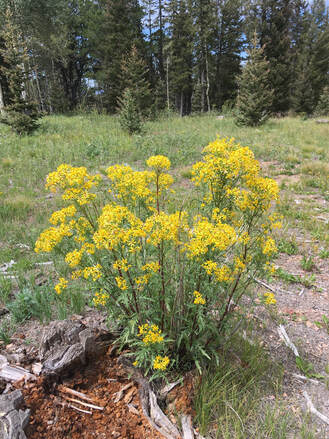 Pic by Penn
Pic by Penn
Senecio eremophilus var. kingii
King's Ragwort or Cut-leaf Groundsel
Perennial - Sub-Shrub
Blooms from June to September. Tall glorious clusters of yellow blooms atop dark red stems up to 3' tall. Deeply incised leaves make for a striking plant. Something to see in full glory.
Likes sandy, rocky soil and can grow to 9,800' I collect it at 10,042'.
Cold stratify or plant in fall.
King's Ragwort or Cut-leaf Groundsel
Perennial - Sub-Shrub
Blooms from June to September. Tall glorious clusters of yellow blooms atop dark red stems up to 3' tall. Deeply incised leaves make for a striking plant. Something to see in full glory.
Likes sandy, rocky soil and can grow to 9,800' I collect it at 10,042'.
Cold stratify or plant in fall.
 Threadleaf Groundsel
Threadleaf Groundsel
Senecio longilobus
Threadleaf Groundsel – 8,000’
Threadleaf Groundsel – 8,000’

Silene cf. noctiflora
Night-flowering Catchfly
Annual Herb
Great addition to the moon garden or anywhere that needs a bit of white. Opens at night, fades the next day.
Night-flowering Catchfly
Annual Herb
Great addition to the moon garden or anywhere that needs a bit of white. Opens at night, fades the next day.

Solidago canadensis
Canada Goldenrod - 7,000'
Grow a glorious stand of Goldenrod this year. Tall, showy bright yellow blooms attract pollinators like bees and butterflies. Highly adaptable - it likes to grow. Although I find it near the river, it can grow dry and moist. It can grow in half shade or full sun. Give it room as it can reach 3-6'. Blooms in fall. Remember, it's the Ragweed, (Ambrosia spp.) flaring up your allergies - not the Goldenrod - but they bloom at the same time!
Medicinal. The name 'Solidago' means 'to make
whole'.
Moist stratify for 1-2 months or plant in fall or
very early spring. Sow lightly, seed is small.
Canada Goldenrod - 7,000'
Grow a glorious stand of Goldenrod this year. Tall, showy bright yellow blooms attract pollinators like bees and butterflies. Highly adaptable - it likes to grow. Although I find it near the river, it can grow dry and moist. It can grow in half shade or full sun. Give it room as it can reach 3-6'. Blooms in fall. Remember, it's the Ragweed, (Ambrosia spp.) flaring up your allergies - not the Goldenrod - but they bloom at the same time!
Medicinal. The name 'Solidago' means 'to make
whole'.
Moist stratify for 1-2 months or plant in fall or
very early spring. Sow lightly, seed is small.

Solidago spathulata nana
Dwarf Goldenrod - 9-10,000’
Dwarf Goldenrod - 9-10,000’

Sphaeralcea parvifolia
Small Leaf Globe Mallow
Can grow hot and dry, and the glowing orange color is something to behold when this beauty puts on mass displays.
Collected at about 6,500 - 7,000' in dry, sandy soil. Plant in fall for best results or stratify for a month before planting. Scarification is also helpful as it has a hard seed coat. Patience might be required, depending on conditions. Stunning! Perennial.
Can grow 3' tall and 4' wide.
Small Leaf Globe Mallow
Can grow hot and dry, and the glowing orange color is something to behold when this beauty puts on mass displays.
Collected at about 6,500 - 7,000' in dry, sandy soil. Plant in fall for best results or stratify for a month before planting. Scarification is also helpful as it has a hard seed coat. Patience might be required, depending on conditions. Stunning! Perennial.
Can grow 3' tall and 4' wide.
 Pic by Penn
Pic by Penn
Stanleya pinnata
Prince's Plume
Growing up in Pueblo West as a small child, I met Stanleya - my what a spectacular plant. A true desert beauty. I see it as high as 6,500'-7,000' but not much higher. It can be grown as an annual at higher elevations or in a protected warm, sunny spot. Full, blazing Colorado sun and lean, lean soils are required to make this happen. A real show stopper - and the pollinator's love it! Spring blooming.
Provide 1-2 months stratification or plant from fall to March in areas with winter. Plant seed lightly. (1/16th")
Perennial
Prince's Plume
Growing up in Pueblo West as a small child, I met Stanleya - my what a spectacular plant. A true desert beauty. I see it as high as 6,500'-7,000' but not much higher. It can be grown as an annual at higher elevations or in a protected warm, sunny spot. Full, blazing Colorado sun and lean, lean soils are required to make this happen. A real show stopper - and the pollinator's love it! Spring blooming.
Provide 1-2 months stratification or plant from fall to March in areas with winter. Plant seed lightly. (1/16th")
Perennial
 Blue-Eyed Grass
Blue-Eyed Grass
Sysyrinchium montanum
Blue-Eyed Grass - 9,000'
This lovely little flower stops me in my tracks. If you are not paying attention, you could walk through the grass and not notice it - unless it has a great year. Blades of grass-like leaves produce this beautiful little flower in deep blue/purple with a bright yellow eye. Grows in the Montane in moist meadows or next to water. Grows only to 20". Not really a grass, Sysyrinchium means "Iris Like", just in the miniature. A great beauty - in a small package. In the Iris family.
Perennial
Blue-Eyed Grass - 9,000'
This lovely little flower stops me in my tracks. If you are not paying attention, you could walk through the grass and not notice it - unless it has a great year. Blades of grass-like leaves produce this beautiful little flower in deep blue/purple with a bright yellow eye. Grows in the Montane in moist meadows or next to water. Grows only to 20". Not really a grass, Sysyrinchium means "Iris Like", just in the miniature. A great beauty - in a small package. In the Iris family.
Perennial
 Pic by Penn
Pic by Penn
Thelesperma filifolium
Navajo Tea - 8,000’
Navajo Tea - 8,000’
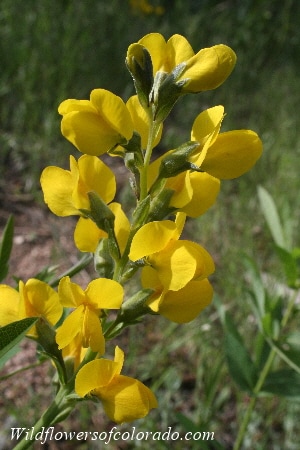
Thermopsis montana
Golden Banner – 9,500’
Golden Banner – 9,500’

Tragopogon porrifolius
Yellow Salsify - Oyster Plant – 8,000’
Yellow Salsify - Oyster Plant – 8,000’
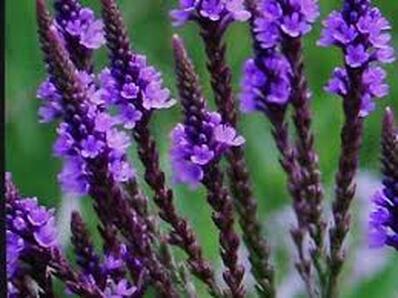 Blue Vervain
Blue Vervain
Verbena hastata
Blue Vervain
Perennial
Deep purple flower spikes rise above spear shaped leaves to 50". This plant is medicinal, ceremonial, beautiful. Pollinators love it. Bloom time from late summer to early fall, bringing a cooling color when it gets hot. Ahhhhh.....
Likes moisture and bottomlands, can take flooding as well as a bit drier soil. Spreads by rhizomes and by seed so give it a place to make it's stand. Cold moist stratify
the seeds for 30 days and plant on the surface, in or out.
Can grow up high or down low. So lovely!
Blue Vervain
Perennial
Deep purple flower spikes rise above spear shaped leaves to 50". This plant is medicinal, ceremonial, beautiful. Pollinators love it. Bloom time from late summer to early fall, bringing a cooling color when it gets hot. Ahhhhh.....
Likes moisture and bottomlands, can take flooding as well as a bit drier soil. Spreads by rhizomes and by seed so give it a place to make it's stand. Cold moist stratify
the seeds for 30 days and plant on the surface, in or out.
Can grow up high or down low. So lovely!

Verbesina encelioides
Cow Pen Daisy
Annual
A showstopper! What is that thing? Any time soil is disturbed in Colorado - Cow Pen Daisy will appear and covers itself in massive amounts of bright, sunny blooms. Drought tolerant - close-to-deer resistant and grows to beautify destruction. What a plant!
After the flash flooding in July of 2018, Cow Pen Daisy emerged and grew huge, prolific plants that got everybody talking. This plant supports late season butterflies and beneficial insects and has medicinal properties. Likes dry soils and conditions. 1-3' tall. Attracts native bees.
Plant on the surface in full sun in spring or fall.
Cow Pen Daisy
Annual
A showstopper! What is that thing? Any time soil is disturbed in Colorado - Cow Pen Daisy will appear and covers itself in massive amounts of bright, sunny blooms. Drought tolerant - close-to-deer resistant and grows to beautify destruction. What a plant!
After the flash flooding in July of 2018, Cow Pen Daisy emerged and grew huge, prolific plants that got everybody talking. This plant supports late season butterflies and beneficial insects and has medicinal properties. Likes dry soils and conditions. 1-3' tall. Attracts native bees.
Plant on the surface in full sun in spring or fall.
 Pic by Penn
Pic by Penn
Yucca glauca
7,888’
7,888’
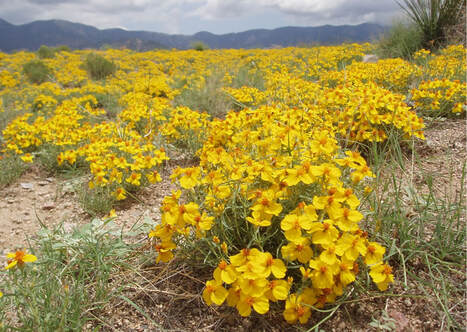
Zinnia grandiflora
Rocky Mountain Zinnia, Little Golden Zinnia, Prairie Zinnia
Wow. The Wild Zinnia of the west! Such a beautiful perennial. Bright yellow rays with orange centers, 6-8" mounds burst with 1" flowers in late summer. I don't see it much above 7,000'. It can take heat, drought and lean soils. Needs good drainage. Plant fall, spring or summer. Moist stratification is helpful but not always necessary. Great for erosion control due to the way it spreads, gravelly slopes and dry hillsides are best for creating a long-lasting stand.
Patience is required but once established, you can let it do its thing.
Beloved Perennial
Rocky Mountain Zinnia, Little Golden Zinnia, Prairie Zinnia
Wow. The Wild Zinnia of the west! Such a beautiful perennial. Bright yellow rays with orange centers, 6-8" mounds burst with 1" flowers in late summer. I don't see it much above 7,000'. It can take heat, drought and lean soils. Needs good drainage. Plant fall, spring or summer. Moist stratification is helpful but not always necessary. Great for erosion control due to the way it spreads, gravelly slopes and dry hillsides are best for creating a long-lasting stand.
Patience is required but once established, you can let it do its thing.
Beloved Perennial
GARDEN FLOWERS

Alcea rosea
Hollyhock Mix - 8,000’
Biennial
Hollyhock Mix - 8,000’
Biennial
 Northern Lights Snapdragon
Northern Lights Snapdragon
Antirrhineae moroccana
Northern Lights Snapdragon
Tender Perennial or Annual
Snapdragons are easy to grow from seed, sow in spring or start in flats and plant 1/16" deep. Grow in full sun to partial shade but a bit of shade will keep them blooming longer if you keep them deadheaded.
They love a cool summer, perfect for the mountain garden or the winter greenhouse. Allow to reseed and naturalize, making for a carefree addition to gorgeous color for most of the summer. Mixed colors.
Northern Lights Snapdragon
Tender Perennial or Annual
Snapdragons are easy to grow from seed, sow in spring or start in flats and plant 1/16" deep. Grow in full sun to partial shade but a bit of shade will keep them blooming longer if you keep them deadheaded.
They love a cool summer, perfect for the mountain garden or the winter greenhouse. Allow to reseed and naturalize, making for a carefree addition to gorgeous color for most of the summer. Mixed colors.

Borago officinalis
Borage - Annual
"Borage for Courage!" What a wonderfully generous plant! It's edible, medicinal, beautiful, attracts pollinators and is a companion to tomatoes - what's not to like?
Easy to grow from seed, direct seed in warm soil or start seedlings and set out. Grows 2-3 feet, I like to give it room to be glorious. Smothered in beneficial insects. I've always put the flowers on my son's birthday cakes - just do. Staple plant here - allow to reseed.
Borage - Annual
"Borage for Courage!" What a wonderfully generous plant! It's edible, medicinal, beautiful, attracts pollinators and is a companion to tomatoes - what's not to like?
Easy to grow from seed, direct seed in warm soil or start seedlings and set out. Grows 2-3 feet, I like to give it room to be glorious. Smothered in beneficial insects. I've always put the flowers on my son's birthday cakes - just do. Staple plant here - allow to reseed.

Centaurea cyanus
Bachelor's Buttons - Mixed Colors
Annual
Easy to grow flowers in blue, pink and white on long stems great for cut flowers. Grey-green leaves. A staple in the flower garden. Delightful, adds color to almost any spot. Fast growing annual is perfect for wildflower stands.
Edible with a sweet and spicy flavor. Loves cool, short season gardens but can take full sun. Another common name is Cornflower.
Direct seed in warm soil or start in flats 4-6 weeks before the last frost date.
Bachelor's Buttons - Mixed Colors
Annual
Easy to grow flowers in blue, pink and white on long stems great for cut flowers. Grey-green leaves. A staple in the flower garden. Delightful, adds color to almost any spot. Fast growing annual is perfect for wildflower stands.
Edible with a sweet and spicy flavor. Loves cool, short season gardens but can take full sun. Another common name is Cornflower.
Direct seed in warm soil or start in flats 4-6 weeks before the last frost date.
 Shasta Daisy - "Alaska"
Shasta Daisy - "Alaska"
Chrysanthemum maximum
Alaska Shasta Daisy – 7,200’
Perennial
Delightful. My mother's favorite flower of all time. To know them is to love them. So easy to grow, plant in spring after last frost or sow inside 6-8 weeks before. Plant seeds on the surface and press in either way.
These plants are long-lived and will form glorious colonies of cheerful flowers.
Grows to 30" and likes full sun to partial sun. I mean LOOK at them..... :)
Alaska Shasta Daisy – 7,200’
Perennial
Delightful. My mother's favorite flower of all time. To know them is to love them. So easy to grow, plant in spring after last frost or sow inside 6-8 weeks before. Plant seeds on the surface and press in either way.
These plants are long-lived and will form glorious colonies of cheerful flowers.
Grows to 30" and likes full sun to partial sun. I mean LOOK at them..... :)

NEW FOR 2023!!
Coreopsis tinctoria
Plains Coreopsis
Annual
Such a stunner! Yellow blooms with a rich red center, this thing is showy. Perfect for the meadow or amongst the garden beds. Makes a wonderful cut flower.
Needs stratification for 4 weeks or plant in fall and early winter. Just cover the seeds and press for good seed to soil contact. Water through germination.
This plant likes it lean and is drought tolerant. Sandy or rocky soil is it's happy place. Too much moisture or rich soil can make them fall over and staking is required. This will give you lots of easy color!
Coreopsis tinctoria
Plains Coreopsis
Annual
Such a stunner! Yellow blooms with a rich red center, this thing is showy. Perfect for the meadow or amongst the garden beds. Makes a wonderful cut flower.
Needs stratification for 4 weeks or plant in fall and early winter. Just cover the seeds and press for good seed to soil contact. Water through germination.
This plant likes it lean and is drought tolerant. Sandy or rocky soil is it's happy place. Too much moisture or rich soil can make them fall over and staking is required. This will give you lots of easy color!

Cosmos bipinnatus
Tall Sensation Cosmos
Annual
Easy-to-grow flower in shades of red, pink and white. Direct seed in spring just under the soil surface. Keep moist through germination. Once established do not over water. They are drought tolerant. These are quite tall and can grow to 60". Plant in full sun and the more often you cut blooms, the more the plant will produce. Allow to self-seed for color for years to come.
Finely cut leaves with large, showy blooms
makes this a favorite of people and pollinators!
Tall Sensation Cosmos
Annual
Easy-to-grow flower in shades of red, pink and white. Direct seed in spring just under the soil surface. Keep moist through germination. Once established do not over water. They are drought tolerant. These are quite tall and can grow to 60". Plant in full sun and the more often you cut blooms, the more the plant will produce. Allow to self-seed for color for years to come.
Finely cut leaves with large, showy blooms
makes this a favorite of people and pollinators!
 Bright Lights Cosmos
Bright Lights Cosmos
Cosmos sulphureus
Bright Lights Cosmos
Annual
These beauties are called Bright Lights for a reason! Semi-double showy blooms from yellow to scarlet-orange grow to 2-3'. This flower is loved by pollinators and blooms heavily from late spring to fall.
Direct seed in spring 1/16", keep planting bed moist until germination, 7-21 days. Once established, this plant is drought tolerant. Can grow in lean soils.
Bright Lights is hardy to zone 3. Finches particularly like the seeds.
Vivid, carefree color all summer long - wow - this annual can deliver!
Bright Lights Cosmos
Annual
These beauties are called Bright Lights for a reason! Semi-double showy blooms from yellow to scarlet-orange grow to 2-3'. This flower is loved by pollinators and blooms heavily from late spring to fall.
Direct seed in spring 1/16", keep planting bed moist until germination, 7-21 days. Once established, this plant is drought tolerant. Can grow in lean soils.
Bright Lights is hardy to zone 3. Finches particularly like the seeds.
Vivid, carefree color all summer long - wow - this annual can deliver!
 Ornamental Carrot "Dara - Pic by Kai
Ornamental Carrot "Dara - Pic by Kai
Dauca carota
Ornamental Carrot - "Dara" - 7,800'
Annual
Wild carrot with a purple twist. This version of Queen Anne's Lace is beautifully colored, starting white to pink to maroon. The plants can get 4' tall with many blooms per plant. A beloved filler cutting flower to make glorious bouquets.
Not edible, although a carrot, this is meant to dance around the garden. Very hardy and easy to grow. Will love full sun and rich soil but it is highly adaptable. Plant in place or start indoors, sow seeds 1/8".
Produces masses of lacy flowers over a long season.
Ornamental Carrot - "Dara" - 7,800'
Annual
Wild carrot with a purple twist. This version of Queen Anne's Lace is beautifully colored, starting white to pink to maroon. The plants can get 4' tall with many blooms per plant. A beloved filler cutting flower to make glorious bouquets.
Not edible, although a carrot, this is meant to dance around the garden. Very hardy and easy to grow. Will love full sun and rich soil but it is highly adaptable. Plant in place or start indoors, sow seeds 1/8".
Produces masses of lacy flowers over a long season.

New For 2023!
Dimorphotheca sinuataAfrican Daisy
Annual
I've loved this plant for many years. It's so easy to grow and it can handle our dry, lean soils. Once established, the plants are fairly drought tolerant. Great for rock gardens, dry places and for attracting pollinators.
Allow to reseed! Cheerful is the right word for this plant.
Dimorphotheca sinuataAfrican Daisy
Annual
I've loved this plant for many years. It's so easy to grow and it can handle our dry, lean soils. Once established, the plants are fairly drought tolerant. Great for rock gardens, dry places and for attracting pollinators.
Allow to reseed! Cheerful is the right word for this plant.
 Purple Coneflower
Purple Coneflower
Echinacea purpurea
Purple Coneflower
Perennial
Absolutely glorious! Beloved! This highly medicinal plant gives us so many gifts they will be hard to list. Blooming from midsummer to fall on hardy, strong plants, Echinacea purpurea will attract the pollinators from far and wide. This is a long lived perennial that will increase it's stand over many years. Give them plenty of room.
Grows 2-4' tall making at least a 2' clump. Plants can be propagated through root divisions after they are mature.
Seed benefits from stratification, but it is not
necessary. It is always good to plant in fall or early
winter.
To speed germination up, you can stratify at 40 degrees for a week and then plant. Plant seed 1/4"
deep. Don't be surprised if it takes these plants two
years to bloom. They like full sun but can grow in partial sun. Hardy to Zone 3. This plant is medicinal, beautiful and beloved by pollinators.
Purple Coneflower
Perennial
Absolutely glorious! Beloved! This highly medicinal plant gives us so many gifts they will be hard to list. Blooming from midsummer to fall on hardy, strong plants, Echinacea purpurea will attract the pollinators from far and wide. This is a long lived perennial that will increase it's stand over many years. Give them plenty of room.
Grows 2-4' tall making at least a 2' clump. Plants can be propagated through root divisions after they are mature.
Seed benefits from stratification, but it is not
necessary. It is always good to plant in fall or early
winter.
To speed germination up, you can stratify at 40 degrees for a week and then plant. Plant seed 1/4"
deep. Don't be surprised if it takes these plants two
years to bloom. They like full sun but can grow in partial sun. Hardy to Zone 3. This plant is medicinal, beautiful and beloved by pollinators.
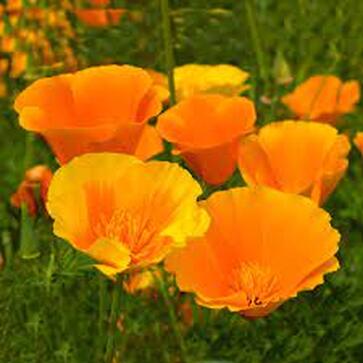
NEW FOR 2023!
Eschscholzia californica
California Poppy
Annual
Highly adaptable California Poppies bring bright and cheerful color to gardens from the seashore to the mountain top. It easily reseeds and is easy to grow.
This plant is drought and heat tolerant and can naturalize almost anywhere. These poppies don't like transplanting so direct seeding is recommended.
Direct seed in spring or fall.
Medicinal
Eschscholzia californica
California Poppy
Annual
Highly adaptable California Poppies bring bright and cheerful color to gardens from the seashore to the mountain top. It easily reseeds and is easy to grow.
This plant is drought and heat tolerant and can naturalize almost anywhere. These poppies don't like transplanting so direct seeding is recommended.
Direct seed in spring or fall.
Medicinal
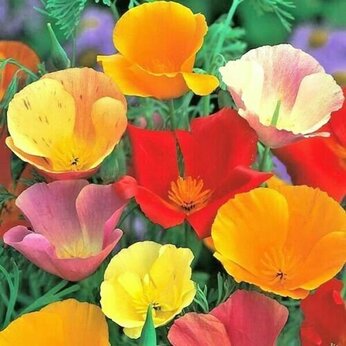
NEW FOR 2023!
Eschscholzia californica
Mixed California Poppy
Annual
This mixture of colorful California Poppy's will delight your soul with the way they dance around the garden. Great for rock gardens and dry conditions, this poppy will add pops of color anywhere you want them.
Easy to grow, plant in fall or spring, 1/8" deep. 60-75 days to maturity, likes sun.
You can start them in pots 4-6 weeks before the last frost.
Small Batch - Limited Quantity
Eschscholzia californica
Mixed California Poppy
Annual
This mixture of colorful California Poppy's will delight your soul with the way they dance around the garden. Great for rock gardens and dry conditions, this poppy will add pops of color anywhere you want them.
Easy to grow, plant in fall or spring, 1/8" deep. 60-75 days to maturity, likes sun.
You can start them in pots 4-6 weeks before the last frost.
Small Batch - Limited Quantity
 Autumn Beauty Sunflower
Autumn Beauty Sunflower
NEW FOR 2023!
Helianthus annus
Autumn Beauty Sunflower
Annual
A fabulous mix of warm tones and autumn colors to accent the late summer garden. 6' tall branching variety adds bold color anywhere in the garden. Full sun and steady moisture will produce the most blooms. Pollinators love sunflowers and the birds will feast on the seeds in winter if you do not harvest them yourself.
Easy to grow, sow seeds after the last frost and when the soil has warmed. 1/4" - 1/2" is deep enough. Sunflowers bloom in late summer, early fall.
Helianthus annus
Autumn Beauty Sunflower
Annual
A fabulous mix of warm tones and autumn colors to accent the late summer garden. 6' tall branching variety adds bold color anywhere in the garden. Full sun and steady moisture will produce the most blooms. Pollinators love sunflowers and the birds will feast on the seeds in winter if you do not harvest them yourself.
Easy to grow, sow seeds after the last frost and when the soil has warmed. 1/4" - 1/2" is deep enough. Sunflowers bloom in late summer, early fall.
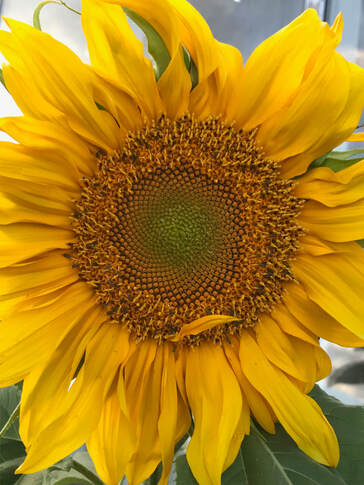 Grey Stripe Sunflower - Pic by Penn
Grey Stripe Sunflower - Pic by Penn
Helianthus annus
Grey Stripe Sunflower
Annual
This is a big ol' Sunflower, in both height and the size of the heads. The seeds are striped white and grey and are delicious to eat. The higher you go in elevation the smaller the heads but this has made it here nicely at 8,000. These plants can grow to 7' or more in the right conditions.
Sunflowers are so cheerful and beautiful. These huge plants will bring joy to your garden. Ours were smothered in pollinators.
Plant 1" deep and 6" apart in rich but well-drained soil. Keep evenly watered for continuous growth and then let the seed-heads dry on the plant if you can. You can put a mesh bag over the heads as they are drying to protect them from birds. Or you can let the birds go for it and they will inadvertently replant for you as they scatter seed.
Blooms late summer, early fall.
Grey Stripe Sunflower
Annual
This is a big ol' Sunflower, in both height and the size of the heads. The seeds are striped white and grey and are delicious to eat. The higher you go in elevation the smaller the heads but this has made it here nicely at 8,000. These plants can grow to 7' or more in the right conditions.
Sunflowers are so cheerful and beautiful. These huge plants will bring joy to your garden. Ours were smothered in pollinators.
Plant 1" deep and 6" apart in rich but well-drained soil. Keep evenly watered for continuous growth and then let the seed-heads dry on the plant if you can. You can put a mesh bag over the heads as they are drying to protect them from birds. Or you can let the birds go for it and they will inadvertently replant for you as they scatter seed.
Blooms late summer, early fall.
 Lesley's Sunflower Mix - Pic by Penn
Lesley's Sunflower Mix - Pic by Penn
Helianthus annus
Lesley's Sunflower Mix
Annual
Sunflower's cross with each other and last year we grew a fabulous diverse crop of them. In this mix of dancing sunflowers are Grey Stripe, Moulin Rouge, Autumn Colors, Tarahumara White, Velvet Queen, Black Seeded, Lemon and our Wild Native Sunflower. There might be more. Some of these will come true and others will be a cross of them all. The Tarahumara grew 10' tall and Grey Stripe made impressively large heads here at 8,000'.
What is a more cheerful plant than a sunflower? I will always grow sunflowers in honor of my sweet, vibrant sister-in-law Lesley, who left this earth way too soon, these were her favorite flower and they are for her.
Enjoy the diversity and love in each packet.
Sow seeds 1/2" deep at least 6" apart. Keep moist through germination. Protect young plants from deer. Critters and birds have been known to dig up the seeds so you can place a bit of screen or cloches over the seeds until they emerge. For me, this only happens sometimes - just a tip. Some of these varieties will get huge, so make sure they have steady moisture and plenty of room. Sunflowers like warm soil to germinate.
Collect seed after the seed-heads have dropped their petals and they begin to dry. They are ready when the birds start to eat them! Harvest whole heads and dry in a well-ventilated area - then enjoy!
(Picture only shows a couple varieties.)
Lesley's Sunflower Mix
Annual
Sunflower's cross with each other and last year we grew a fabulous diverse crop of them. In this mix of dancing sunflowers are Grey Stripe, Moulin Rouge, Autumn Colors, Tarahumara White, Velvet Queen, Black Seeded, Lemon and our Wild Native Sunflower. There might be more. Some of these will come true and others will be a cross of them all. The Tarahumara grew 10' tall and Grey Stripe made impressively large heads here at 8,000'.
What is a more cheerful plant than a sunflower? I will always grow sunflowers in honor of my sweet, vibrant sister-in-law Lesley, who left this earth way too soon, these were her favorite flower and they are for her.
Enjoy the diversity and love in each packet.
Sow seeds 1/2" deep at least 6" apart. Keep moist through germination. Protect young plants from deer. Critters and birds have been known to dig up the seeds so you can place a bit of screen or cloches over the seeds until they emerge. For me, this only happens sometimes - just a tip. Some of these varieties will get huge, so make sure they have steady moisture and plenty of room. Sunflowers like warm soil to germinate.
Collect seed after the seed-heads have dropped their petals and they begin to dry. They are ready when the birds start to eat them! Harvest whole heads and dry in a well-ventilated area - then enjoy!
(Picture only shows a couple varieties.)
 Velvet Queen Sunflower
Velvet Queen Sunflower
NEW FOR 2023!
Helianthus annus
Velvet Queen Sunflower
Annual
I can't get enough of these gorgeous sunflowers. 6' plants produce flowers in shades of burgundy and bronze, perfect for any garden. Beautiful contrasting with other sunflowers and they make a wonderful cut flower too.
Direct sow in spring after the soil warms up and all chance of frost is past. Do not bury the seeds too deeply, 1/4" will do. Keep well watered through germination. I mulch my sunflowers to help keep steady moisture.
Helianthus annus
Velvet Queen Sunflower
Annual
I can't get enough of these gorgeous sunflowers. 6' plants produce flowers in shades of burgundy and bronze, perfect for any garden. Beautiful contrasting with other sunflowers and they make a wonderful cut flower too.
Direct sow in spring after the soil warms up and all chance of frost is past. Do not bury the seeds too deeply, 1/4" will do. Keep well watered through germination. I mulch my sunflowers to help keep steady moisture.
 Pic by Penn
Pic by Penn
Ipomoea purpurea
Grandpa Ott's Morning Glory
Re-seeding Annual 8,000'
This is one of the seeds that started the Seed Saver's Exchange! Glorious deep purple flowers with a red throat. It can climb 15', no problem. One of my favorite flowers from my childhood. I remember running outside in the morning to see them in all their glory. Now they climb all around the greenhouse, making me just as happy.
Easy to grow from seed.
Grandpa Ott's Morning Glory
Re-seeding Annual 8,000'
This is one of the seeds that started the Seed Saver's Exchange! Glorious deep purple flowers with a red throat. It can climb 15', no problem. One of my favorite flowers from my childhood. I remember running outside in the morning to see them in all their glory. Now they climb all around the greenhouse, making me just as happy.
Easy to grow from seed.

Lathyrus latifolius
Perennial Sweet Pea - 5,000’
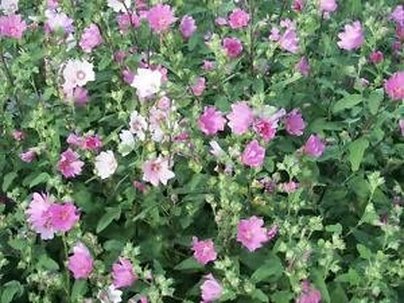
Lavatera trimestris
Rose Mallow
Perennial
Rose Mallow
Perennial

Nicandra physalodes
“Ebony” - Ebony Shoo-fly – 8,000’
Ebony Shoo-fly is a 3-4 foot annual flowering shrub. Morning glory-like flowers leave Chinese lantern-like seed pods behind - beautiful! Can get much bigger in the greenhouse. Starts easily and reseeds easily from seed.
“Ebony” - Ebony Shoo-fly – 8,000’
Ebony Shoo-fly is a 3-4 foot annual flowering shrub. Morning glory-like flowers leave Chinese lantern-like seed pods behind - beautiful! Can get much bigger in the greenhouse. Starts easily and reseeds easily from seed.

Orlaya grandiflora
White Lace Flower - Annual
Such a pretty flower, the petals like lace. Add bright white to your flower beds with this easy to grow beauty. Allow to reseed or plant where you want. Looks incredible en masse.
White Lace Flower - Annual
Such a pretty flower, the petals like lace. Add bright white to your flower beds with this easy to grow beauty. Allow to reseed or plant where you want. Looks incredible en masse.
 Iceland Poppy
Iceland Poppy
Papaver nudicaule
Iceland Poppy
Perennial
Mixed colors of delicate poppies rise above pleasing rosettes of soft leaves. Looks fragile but is tough as nails, hardy to the coldest climates. This poppy does like it cool more than hot. White, Yellow and Orange-Red colors will come on easily from seed.
Plant in spring or in fall, but sow on the surface, gently pressing the soil for good seed-to-soil contact.
Grows to 18", is most charming and is a good companion for other flowers. Bees and butterflies will love you for growing these. Perfect for the mountains. This plant originates in Arctic regions.
Iceland Poppy
Perennial
Mixed colors of delicate poppies rise above pleasing rosettes of soft leaves. Looks fragile but is tough as nails, hardy to the coldest climates. This poppy does like it cool more than hot. White, Yellow and Orange-Red colors will come on easily from seed.
Plant in spring or in fall, but sow on the surface, gently pressing the soil for good seed-to-soil contact.
Grows to 18", is most charming and is a good companion for other flowers. Bees and butterflies will love you for growing these. Perfect for the mountains. This plant originates in Arctic regions.
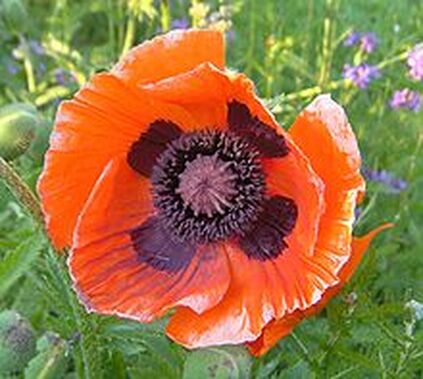 Oriental Poppy
Oriental Poppy
Papaver orientale
Oriental Poppy
Perennial
Expect incredible waves of red-orange poppy flowers in late spring and early summer. This hardy plant can grow up high or down low, in the desert heat and the mountaintop. Stunning displays will reseed themselves easily. If you want to see some bees go crazy - sow poppies!
Sow seed in spring, no stratification necessary with this poppy and sow on the surface of the soil and gently press them in. You can sow these seeds in late fall or early winter as well.
Grows to 3', germinates in two to three weeks. Their roots do not like to be disturbed so plant them where you want them. You can also start them indoors 6-8 weeks before the last frost date.
I've seen old stands of these all over the Rockies, a glorious harbinger of Spring!
Oriental Poppy
Perennial
Expect incredible waves of red-orange poppy flowers in late spring and early summer. This hardy plant can grow up high or down low, in the desert heat and the mountaintop. Stunning displays will reseed themselves easily. If you want to see some bees go crazy - sow poppies!
Sow seed in spring, no stratification necessary with this poppy and sow on the surface of the soil and gently press them in. You can sow these seeds in late fall or early winter as well.
Grows to 3', germinates in two to three weeks. Their roots do not like to be disturbed so plant them where you want them. You can also start them indoors 6-8 weeks before the last frost date.
I've seen old stands of these all over the Rockies, a glorious harbinger of Spring!
 Shirley Poppy
Shirley Poppy
Papaver rhoeas
Shirley Poppy
Annual
Easy to grow, marvelous deep red poppies play beautifully with others. Pollinators love all poppies, and this intense red color will bring them in with gusto.
Blooms from early summer to late summer, to 24" and can take full sun to partial sun.
This is a reseeding annual and you can sow it in very early spring or late fall. Barely cover the seed. Keep moist through germination if sown in spring or water in fall and winter if there is no precipitation for 30 days.
My mother's name was Shirley - these are for her.
Shirley Poppy
Annual
Easy to grow, marvelous deep red poppies play beautifully with others. Pollinators love all poppies, and this intense red color will bring them in with gusto.
Blooms from early summer to late summer, to 24" and can take full sun to partial sun.
This is a reseeding annual and you can sow it in very early spring or late fall. Barely cover the seed. Keep moist through germination if sown in spring or water in fall and winter if there is no precipitation for 30 days.
My mother's name was Shirley - these are for her.
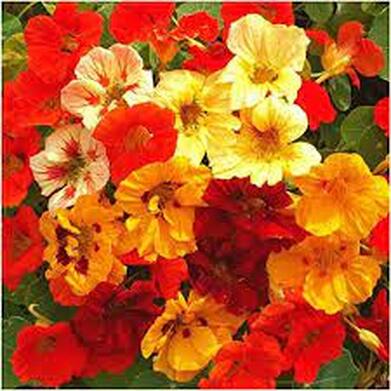 Nasturtium - "Alaska"
Nasturtium - "Alaska"
New For 2023!
Tropaeolum nanum
Jewel Nasturtium
Annual
Easy to grow bursts of edible color fit in anywhere. I plant these in hanging baskets, containers, garden beds and the greenhouses. The leaves and flowers are a delicious addition to the salad. The leaves are spicy and the flowers are sweet and spicy.
Waves of yellows, oranges and reds in solid and bi-color flowers come with large, round, green leaves that seem to float in mid air.
We also use Nasturtium as a trap crop in the squash bed to deter squash beetles. So far so good! Green seeds pickle well, sometimes called "Poor Man's Capers".
This is a staple crop for us and it is so easy to grow! Direct seed in the garden or start in pots 2-4 weeks before the last frost. Young, sturdy plants transplant best. You can direct seed these into hanging baskets and containers as well.
Plant 1/4"-1/2" deep. I've grown them in full sun and full shade. Do not fertilize or you will get more leaves than flowers. Can take lean soil. You can nick or soak the seeds before planting but I have never needed to.
Nasturtiums are a part of life.
Tropaeolum nanum
Jewel Nasturtium
Annual
Easy to grow bursts of edible color fit in anywhere. I plant these in hanging baskets, containers, garden beds and the greenhouses. The leaves and flowers are a delicious addition to the salad. The leaves are spicy and the flowers are sweet and spicy.
Waves of yellows, oranges and reds in solid and bi-color flowers come with large, round, green leaves that seem to float in mid air.
We also use Nasturtium as a trap crop in the squash bed to deter squash beetles. So far so good! Green seeds pickle well, sometimes called "Poor Man's Capers".
This is a staple crop for us and it is so easy to grow! Direct seed in the garden or start in pots 2-4 weeks before the last frost. Young, sturdy plants transplant best. You can direct seed these into hanging baskets and containers as well.
Plant 1/4"-1/2" deep. I've grown them in full sun and full shade. Do not fertilize or you will get more leaves than flowers. Can take lean soil. You can nick or soak the seeds before planting but I have never needed to.
Nasturtiums are a part of life.
 Zinnia - California Giants
Zinnia - California Giants
Zinnia elegans
Zinnia - "California Giants"
Annual
Large, colorful flowers will grow to 3'! Easy-to-grow annual - direct seed in spring once the soil warms up. Better to wait for warm soil than plant too soon, especially in cool climates.
Sow seeds just below the surface, press in for good seed to soil contact. Keep moist until germination. Plant amongst the vegetables to attract pollinators.
Mixed colors.
Zinnia - "California Giants"
Annual
Large, colorful flowers will grow to 3'! Easy-to-grow annual - direct seed in spring once the soil warms up. Better to wait for warm soil than plant too soon, especially in cool climates.
Sow seeds just below the surface, press in for good seed to soil contact. Keep moist until germination. Plant amongst the vegetables to attract pollinators.
Mixed colors.
HERBS - GARDEN AND WILD

Achillea millefolium
White Yarrow
Oh Yarrow, what can't you do? I've loved this soft, white flower all of my life. It is excellent medicine and perfect for the pharmaceutical garden. It's uses are too vast to list. Blooms June-August.
Sow seed very lightly or on the soil surface in Spring, Summer or Fall. It can really grow anywhere - full sun to full shade. Grows from the plains to the alpine. Perennial.
White Yarrow
Oh Yarrow, what can't you do? I've loved this soft, white flower all of my life. It is excellent medicine and perfect for the pharmaceutical garden. It's uses are too vast to list. Blooms June-August.
Sow seed very lightly or on the soil surface in Spring, Summer or Fall. It can really grow anywhere - full sun to full shade. Grows from the plains to the alpine. Perennial.
 Chives
Chives
Allium schoenoprasum
Chives - 8,000'
Perennial
Slender, onion flavored leaves are topped with lavender to purple showy flowers. Flowers and leaves are edible. Makes an excellent addition to salad or to top the main dish. You can eat them raw, cook with them or dry them for soups and stews.
Easy to grow, direct seed or start in flats 6-8 weeks before setting out. These are a beautiful addition to the flower border as well.
We use all alliums as a aromatic protector to deter critters. Good companion plant.
Chives - 8,000'
Perennial
Slender, onion flavored leaves are topped with lavender to purple showy flowers. Flowers and leaves are edible. Makes an excellent addition to salad or to top the main dish. You can eat them raw, cook with them or dry them for soups and stews.
Easy to grow, direct seed or start in flats 6-8 weeks before setting out. These are a beautiful addition to the flower border as well.
We use all alliums as a aromatic protector to deter critters. Good companion plant.

Allium tuberosa
Garlic Chives – 8,000’
Perennial
My favorite chive of all time! Leaves and flowers are edible, this absolutely hardy perennial will grow everywhere and anywhere. Willing to say the least. Flat, green garlic-tasting chive leaves are delectable served with Fondue. We chop them onto the pizza, the salad, soups and stews, sandwiches. The star flowers make a beautiful, edible garnish.
Drought tolerant. It pops up in full sun and partial shade. Can remain evergreen in warmer areas. Easy to start or direct seed. Allow to reseed!
Garlic Chives – 8,000’
Perennial
My favorite chive of all time! Leaves and flowers are edible, this absolutely hardy perennial will grow everywhere and anywhere. Willing to say the least. Flat, green garlic-tasting chive leaves are delectable served with Fondue. We chop them onto the pizza, the salad, soups and stews, sandwiches. The star flowers make a beautiful, edible garnish.
Drought tolerant. It pops up in full sun and partial shade. Can remain evergreen in warmer areas. Easy to start or direct seed. Allow to reseed!

Anethum graveolens
Mammoth Dill - 8,000’
This dill has deep green leaves with very large seed heads, perfect for making pickles! It is a bit earlier than the average dill and it can grow to 36". I've seen it grow even taller.
Sow seeds no more than 1/4" deep and thin to 8" apart. Dill does not transplant well so direct seed where you want it. If you let some reseed, you will always have dill.
After they germinate, mulch to keep the soil evenly moist. If the soil dries out, it will trigger it to go to seed. Both the leaves and the seeds are edible and delicious.
A staple in the kitchen garden. Pollinators love this plant. Medicinal.
Mammoth Dill - 8,000’
This dill has deep green leaves with very large seed heads, perfect for making pickles! It is a bit earlier than the average dill and it can grow to 36". I've seen it grow even taller.
Sow seeds no more than 1/4" deep and thin to 8" apart. Dill does not transplant well so direct seed where you want it. If you let some reseed, you will always have dill.
After they germinate, mulch to keep the soil evenly moist. If the soil dries out, it will trigger it to go to seed. Both the leaves and the seeds are edible and delicious.
A staple in the kitchen garden. Pollinators love this plant. Medicinal.

Calendula officianalis
Pot Marigold - 8,000’
Annual
A must have in any garden. Beautiful, easy-to-grow, bright orange and yellow flowers are edible, medicinal, loved by pollinators and are a great companion to other plants.
Direct seed or start in pots about 4 weeks before the last frost.
Pot Marigold - 8,000’
Annual
A must have in any garden. Beautiful, easy-to-grow, bright orange and yellow flowers are edible, medicinal, loved by pollinators and are a great companion to other plants.
Direct seed or start in pots about 4 weeks before the last frost.

NEW FOR 2023!
Coriandrum sativum
Cilantro/Coriander
Annual
There is no middle ground when it comes to Cilantro - you either love it or hate it. I love it of course but here's the deal. Cilantro and Coriander are the same plant. Cilantro is what we call the tender, delicious green leaves and Coriander is the fragrant fruiting bodies, (the seeds), after it flowers. The seeds are edible and they readily give you more seed to plant so you always have young, tender cilantro leaves - whenever you want them.
They are so easy to grow, you can start some seeds in containers in the windowsill, plant a row or broadcast the seed around the garden and let them find their way. Cilantro is incredibly frost tolerant!
Cilantro is known for bolting quickly so succession planting is recommended. If you prefer the seed as a spice, let 'em go to seed!
Pollinators love the flowering tops.
Original seed from Jesus Flores, a high altitude farmer we admire so much.
Coriandrum sativum
Cilantro/Coriander
Annual
There is no middle ground when it comes to Cilantro - you either love it or hate it. I love it of course but here's the deal. Cilantro and Coriander are the same plant. Cilantro is what we call the tender, delicious green leaves and Coriander is the fragrant fruiting bodies, (the seeds), after it flowers. The seeds are edible and they readily give you more seed to plant so you always have young, tender cilantro leaves - whenever you want them.
They are so easy to grow, you can start some seeds in containers in the windowsill, plant a row or broadcast the seed around the garden and let them find their way. Cilantro is incredibly frost tolerant!
Cilantro is known for bolting quickly so succession planting is recommended. If you prefer the seed as a spice, let 'em go to seed!
Pollinators love the flowering tops.
Original seed from Jesus Flores, a high altitude farmer we admire so much.

Euphorbia lathyrus
Moleplant
This groovy biennial is also called Gopher Spurge as it puts a volatile oil in the soil that ground animals avoid. We plant these throughout the vegetable garden to discourage the critters. This is not a perfect fix but it is an excellent contribution to Integrated Pest Management, working along with other solutions.
Grow it as a Biennial in lower elevations, but up high you will have to grow it as an annual. We plant it with the vegetables outside and then let a few bloom in the greenhouses. They produce a green flower with green seed pods that ripen to brown.
Easy to grow - no pre-treatment necessary. I start them in plug trays and plant the plugs right in. Vigorous growers. In the greenhouse, they can reach 12'! Outside, more like 12-18". Non-Invasive.
Moleplant
This groovy biennial is also called Gopher Spurge as it puts a volatile oil in the soil that ground animals avoid. We plant these throughout the vegetable garden to discourage the critters. This is not a perfect fix but it is an excellent contribution to Integrated Pest Management, working along with other solutions.
Grow it as a Biennial in lower elevations, but up high you will have to grow it as an annual. We plant it with the vegetables outside and then let a few bloom in the greenhouses. They produce a green flower with green seed pods that ripen to brown.
Easy to grow - no pre-treatment necessary. I start them in plug trays and plant the plugs right in. Vigorous growers. In the greenhouse, they can reach 12'! Outside, more like 12-18". Non-Invasive.

Leonurus cardiaca
Motherwort - 8,000’
Motherwort - 8,000’
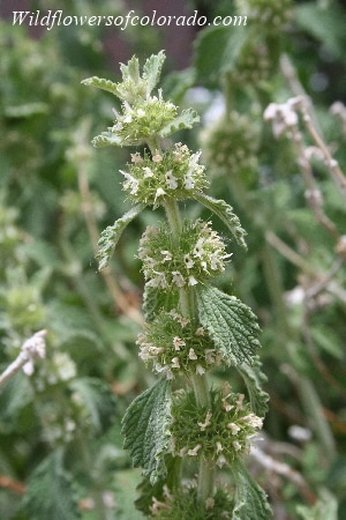
Marrubium vulgare
Horehound – 6,000’
Horehound – 6,000’
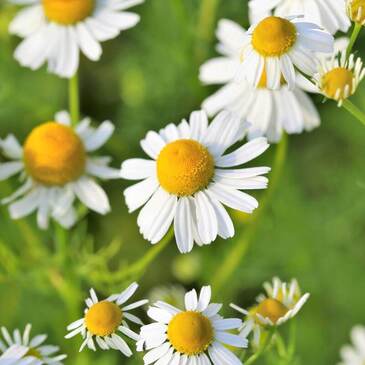
NEW FOR 2023!
Matricaria recutita
Chamomile
Probably one of the most beloved tea herbs of all time, Chamomile offers a long list of benefits, including as a sleep aid, supporting digestion, and helps with skin care. It smells delightfully like apples and the plants are beautiful, with finely cut, soft leaves smothered in small daisy-like flowers that make the most delicious tea.
Can grow up to 2' and look great planted in clusters, rows or broadcast throughout the garden. Chamomile is a companion to all plants, and people!
Small Batch - Limited Quantity
Matricaria recutita
Chamomile
Probably one of the most beloved tea herbs of all time, Chamomile offers a long list of benefits, including as a sleep aid, supporting digestion, and helps with skin care. It smells delightfully like apples and the plants are beautiful, with finely cut, soft leaves smothered in small daisy-like flowers that make the most delicious tea.
Can grow up to 2' and look great planted in clusters, rows or broadcast throughout the garden. Chamomile is a companion to all plants, and people!
Small Batch - Limited Quantity

NEW FOR 2023!
Melissa officinalis
Lemon Balm
Perennial
Have a soothing cup of tea at the end of the day. Dark green, crinkled leaves are loaded with essential oils. A great stress reliever and aids in digestion too. Melissa is there to soothe your headache as well.
This perennial plant will expand in happy
conditions.
Direct seed or start seeds in pots 6 weeks
before the last frost. Beloved.
Small Batch - Limited Quantity
Melissa officinalis
Lemon Balm
Perennial
Have a soothing cup of tea at the end of the day. Dark green, crinkled leaves are loaded with essential oils. A great stress reliever and aids in digestion too. Melissa is there to soothe your headache as well.
This perennial plant will expand in happy
conditions.
Direct seed or start seeds in pots 6 weeks
before the last frost. Beloved.
Small Batch - Limited Quantity
 Spearmint
Spearmint
Mentha spicata
Spearmint
Perennial
Spearmint can be direct sown in place in the spring or started indoors 8-10 weeks before the last frost. Plant the seed 1/16-1/8 inch. Plant in place as all mints will spread by the roots and make a wonderful stand. Plants can grow to 3'. Soft, lavender flower spikes shoot up from the dark green, crinkled leaves. It needs moisture to thrive but prefers well draining soils.
Spearmint has a sweetness to it and has been beloved for generations as tea, food and medicine. Add this to your kitchen garden - a must have.
Limited Quantity
Spearmint
Perennial
Spearmint can be direct sown in place in the spring or started indoors 8-10 weeks before the last frost. Plant the seed 1/16-1/8 inch. Plant in place as all mints will spread by the roots and make a wonderful stand. Plants can grow to 3'. Soft, lavender flower spikes shoot up from the dark green, crinkled leaves. It needs moisture to thrive but prefers well draining soils.
Spearmint has a sweetness to it and has been beloved for generations as tea, food and medicine. Add this to your kitchen garden - a must have.
Limited Quantity
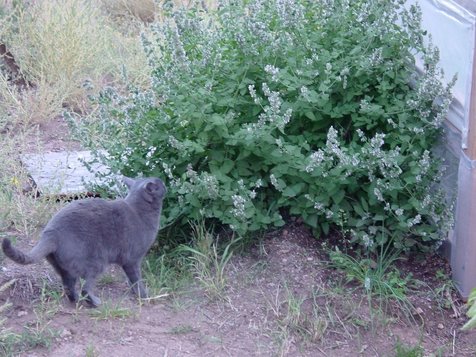
Nepeta cataria
Catnip - 8,000'

BACK FOR 2023!
Ocimum basilicum
Italian Mountain Basil
Annual
Oh boy oh boy! My favorite Basil of all time is back! I love hanging planters of this basil in the Piñon trees here in our Forest Garden. It can take cooler temperatures than most Basils and just seems to thrive in the mountains. It is a delicious, sweet basil and it bolts later than most. The plants are a bit sturdier than some, with deeply green, glossy leaves.
I highly recommend trying this Basil not only for its excellent flavor, but for its adaptation to the mountains.
Direct seed into garden beds or start seeds about 4-6 weeks before the last frost.
Ocimum basilicum
Italian Mountain Basil
Annual
Oh boy oh boy! My favorite Basil of all time is back! I love hanging planters of this basil in the Piñon trees here in our Forest Garden. It can take cooler temperatures than most Basils and just seems to thrive in the mountains. It is a delicious, sweet basil and it bolts later than most. The plants are a bit sturdier than some, with deeply green, glossy leaves.
I highly recommend trying this Basil not only for its excellent flavor, but for its adaptation to the mountains.
Direct seed into garden beds or start seeds about 4-6 weeks before the last frost.

Origanum vulgare
Italian Oregano – 8,000’ Perennial
Oregano is a easy to grow culinary and medicinal herb that thrives in the mountains. Purple flowers on top of dark green leaves make it a beauty for the flower garden.
Can't live without it, my plants have lasted many years here at 8,000'. All aromatics help protect the garden from the bugs we don't want, while attracting the bugs we do. A must have. I want pizza!
Italian Oregano – 8,000’ Perennial
Oregano is a easy to grow culinary and medicinal herb that thrives in the mountains. Purple flowers on top of dark green leaves make it a beauty for the flower garden.
Can't live without it, my plants have lasted many years here at 8,000'. All aromatics help protect the garden from the bugs we don't want, while attracting the bugs we do. A must have. I want pizza!
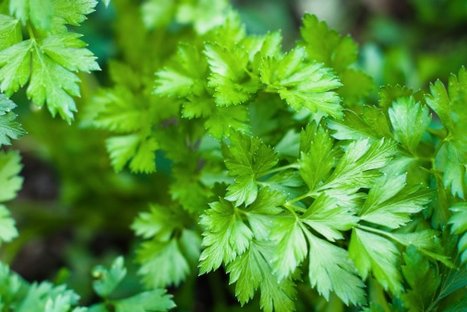
Petroselinum crispum
Italian Flatleaf Parsley
Biennial
Petroselinum crispumItalian Flat-Leaf Parsley
Biennial
An absolute staple in my gardens and in my kitchen. Parsley is so good for us too - giving us both culinary and medicinal benefits. You can direct seed straight into garden beds or start in pots a good 6 weeks before the last frost. Give it time to germinate as it has a very hard seed coat. You can pre-soak the seeds before planting if you want. The first year the plant will produce a leafy plant and the second year it will flower and produce the seed.
Pollinators love the umble flowers and if you let it drop seed, you will always have parsley. It is very hardy and will grow in any soil. In the greenhouse, the first year plants can get huge! Outside the second year flowers will grow to about 2-3'.
I consider parsley to be in the 'free food' category. Let it dance!
Italian Flatleaf Parsley
Biennial
Petroselinum crispumItalian Flat-Leaf Parsley
Biennial
An absolute staple in my gardens and in my kitchen. Parsley is so good for us too - giving us both culinary and medicinal benefits. You can direct seed straight into garden beds or start in pots a good 6 weeks before the last frost. Give it time to germinate as it has a very hard seed coat. You can pre-soak the seeds before planting if you want. The first year the plant will produce a leafy plant and the second year it will flower and produce the seed.
Pollinators love the umble flowers and if you let it drop seed, you will always have parsley. It is very hardy and will grow in any soil. In the greenhouse, the first year plants can get huge! Outside the second year flowers will grow to about 2-3'.
I consider parsley to be in the 'free food' category. Let it dance!

NEW FOR 2023!
Rumex acetosa
Sorrel
Perennial
Essential food/herb for every garden. One of the toughest, earliest, consistent, delicious, multi-purpose herbs I know. Sorrel is extremely hardy and long-lived. Drought tolerant. Deep taproot anchors the plant and creates community with other plants.
Edible, (we wrap trout in sorrel leaves), and we chop it
into salads raw. Lemon flavored.
Small Batch - Limited Quantity
Rumex acetosa
Sorrel
Perennial
Essential food/herb for every garden. One of the toughest, earliest, consistent, delicious, multi-purpose herbs I know. Sorrel is extremely hardy and long-lived. Drought tolerant. Deep taproot anchors the plant and creates community with other plants.
Edible, (we wrap trout in sorrel leaves), and we chop it
into salads raw. Lemon flavored.
Small Batch - Limited Quantity
 Broadleaf Sage
Broadleaf Sage
Salvia officinalis
Broadleaf Sage
Perennial
Grey-green leaves add contrast to the stunning deep blue/purple flowers that rise above the foliage. Can grow 18-36". Delicious and medicinal, sage has long been used to flavor wild meats, pork, stuffing, beans, soups, stews and anything that floats your boat.
The plant becomes semi-woody and the flowers are edible. Can be used fresh or dried. This is another long-lived perennial culinary herb for your kitchen.
Can be direct seeded after the soil is warmed above 50 degrees or sow in flats 6-10 weeks before last frost date. Plant 1/4" deep, germination in 7-21 days.
Broadleaf Sage
Perennial
Grey-green leaves add contrast to the stunning deep blue/purple flowers that rise above the foliage. Can grow 18-36". Delicious and medicinal, sage has long been used to flavor wild meats, pork, stuffing, beans, soups, stews and anything that floats your boat.
The plant becomes semi-woody and the flowers are edible. Can be used fresh or dried. This is another long-lived perennial culinary herb for your kitchen.
Can be direct seeded after the soil is warmed above 50 degrees or sow in flats 6-10 weeks before last frost date. Plant 1/4" deep, germination in 7-21 days.
 Black Elderberry
Black Elderberry
NEW FOR 2023!
Sambucus nigra
Black Elderberry
Plant the seeds of this shrub 1/4" deep in fall and expect the seed to germinate the second spring. This plant is an important investment in the future, could take five years to get established and produce. It will be worth the wait.
Nectar rich flowers that the pollinators love, tart, antioxidant-rich, almost black berries, with beautiful green leaves to offset the incredible color. Excellent plant for wildlife of all kinds. This is an absolutely gorgeous plant.
Medicinal uses are many, from cough syrup to cordials and
wine.
Small Batch - Limited Quantity
Sambucus nigra
Black Elderberry
Plant the seeds of this shrub 1/4" deep in fall and expect the seed to germinate the second spring. This plant is an important investment in the future, could take five years to get established and produce. It will be worth the wait.
Nectar rich flowers that the pollinators love, tart, antioxidant-rich, almost black berries, with beautiful green leaves to offset the incredible color. Excellent plant for wildlife of all kinds. This is an absolutely gorgeous plant.
Medicinal uses are many, from cough syrup to cordials and
wine.
Small Batch - Limited Quantity
 Large African Marigold
Large African Marigold
Tagetes erecta
Large African Marigold - 8,000' Annual
Crackerjack
Very tall, 3' big ol' puffballs. These can grow up out of the vegetables for awesome companion planting. Big color, big flowers, big impact.
Blooms easily from seed. Easy to grow.
Pollinators love Marigolds.
Protect your garden with these giant beauties.
Large African Marigold - 8,000' Annual
Crackerjack
Very tall, 3' big ol' puffballs. These can grow up out of the vegetables for awesome companion planting. Big color, big flowers, big impact.
Blooms easily from seed. Easy to grow.
Pollinators love Marigolds.
Protect your garden with these giant beauties.

Tanacetum parthenium
Feverfew – 8,000’
Feverfew – 8,000’

Valeriana officinali
Common Valerian
Common Valerian
Trees

Gleditisia triacanthos L.
Honey Locust – 5,000’
Honey Locust – 5,000’
 Pic by Penn
Pic by Penn
Crataegus rivularis
River Hawthorne
The seeds from this plant come from a very old Hawthorne tree. I only have a limited supply but even a little will get you started. Growing at 7,500' for decades, it clings to swampy or bottomland areas, including stream sides. Medicinal, edible, beautiful.
From my mentor's garden.
Long-lived perennial. Pic shows drying Hawthorne berries.
Cold stratify or plant in fall.
River Hawthorne
The seeds from this plant come from a very old Hawthorne tree. I only have a limited supply but even a little will get you started. Growing at 7,500' for decades, it clings to swampy or bottomland areas, including stream sides. Medicinal, edible, beautiful.
From my mentor's garden.
Long-lived perennial. Pic shows drying Hawthorne berries.
Cold stratify or plant in fall.

Pinus edulis
Piñon Pine Tree - 8,000'
Piñon Pine Tree - 8,000'


